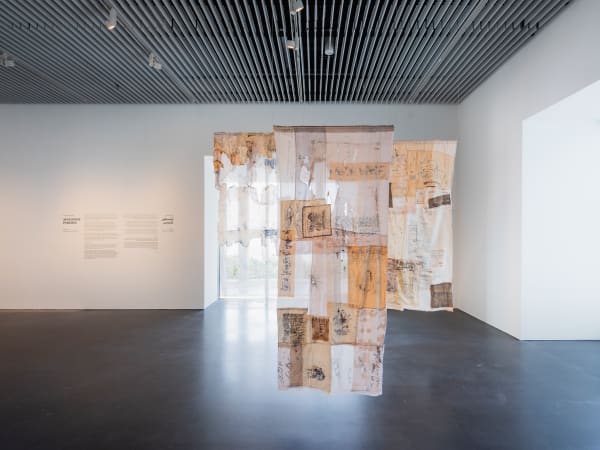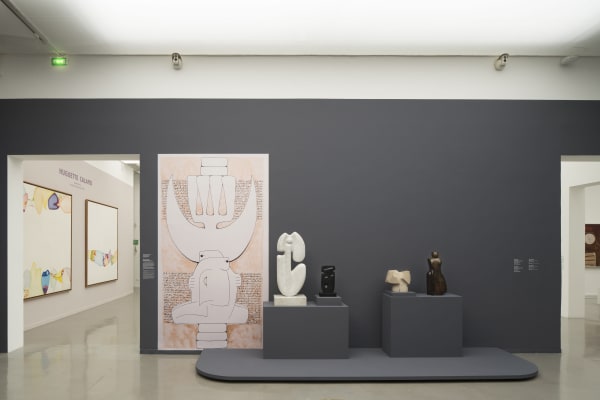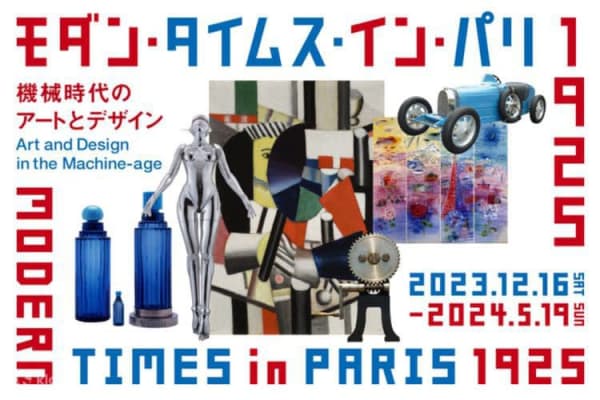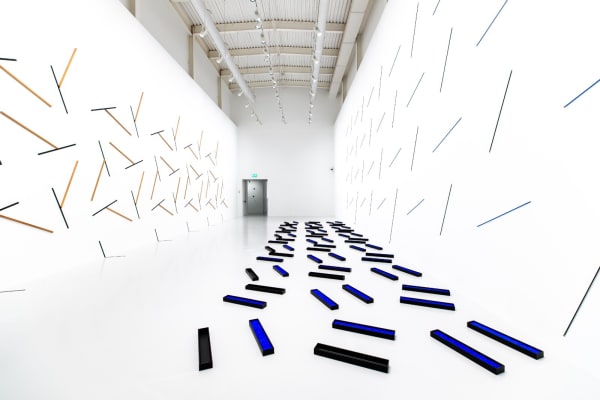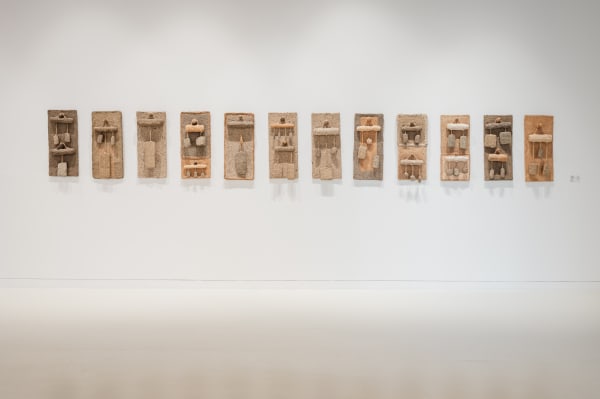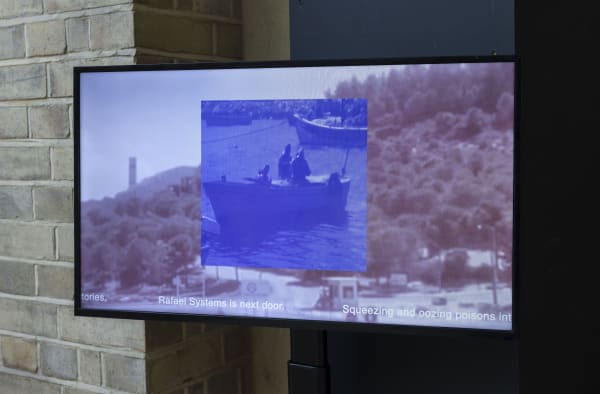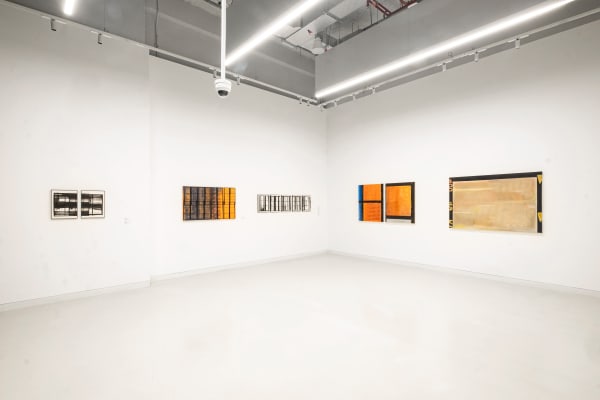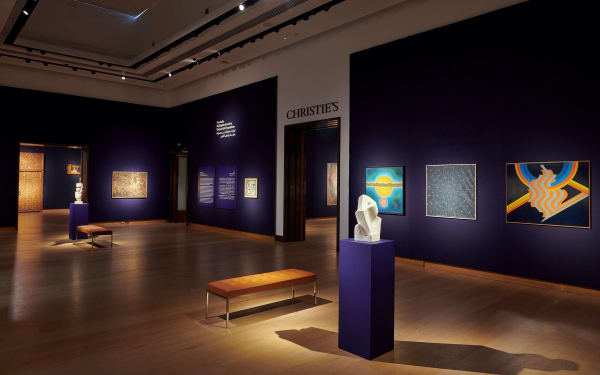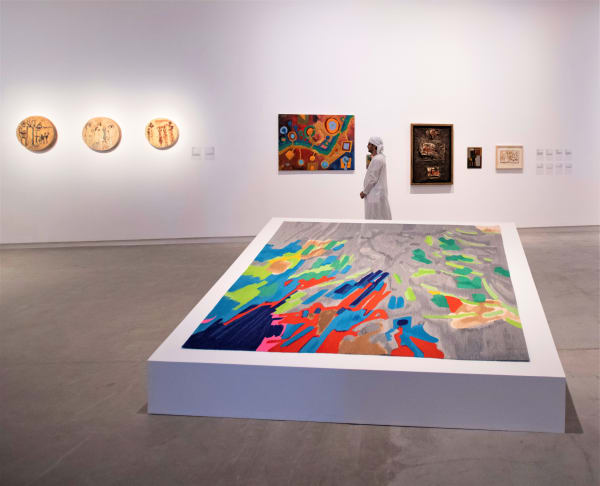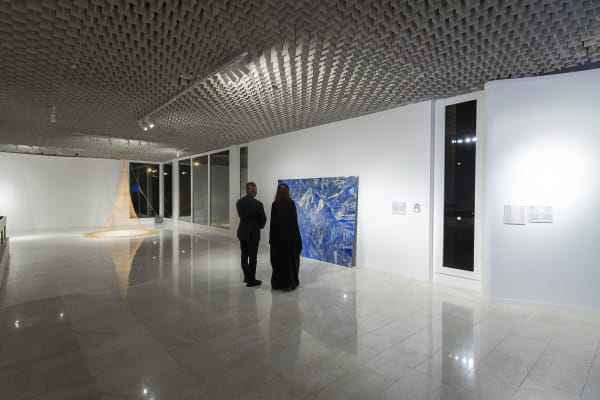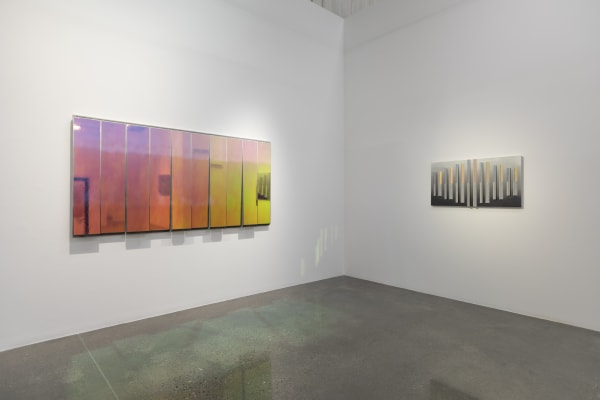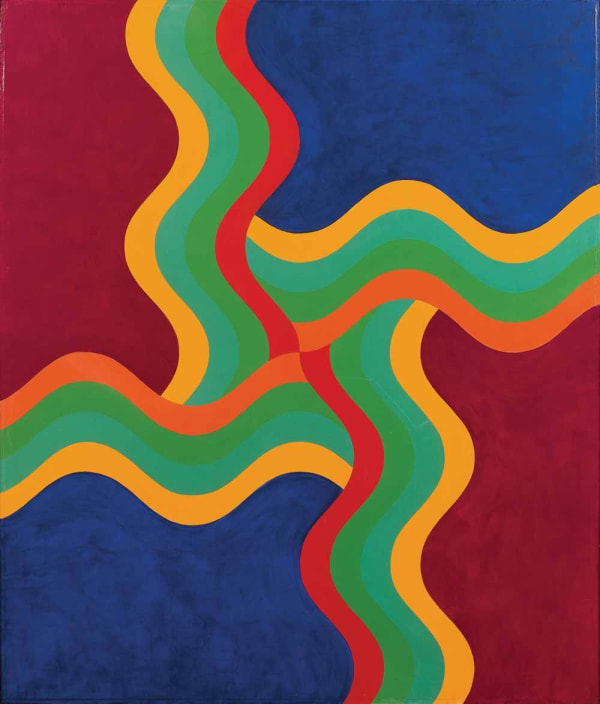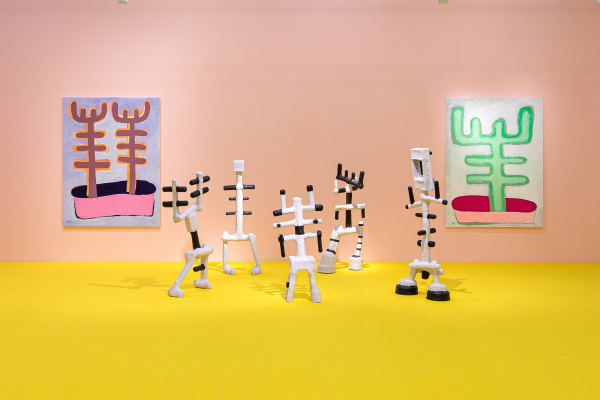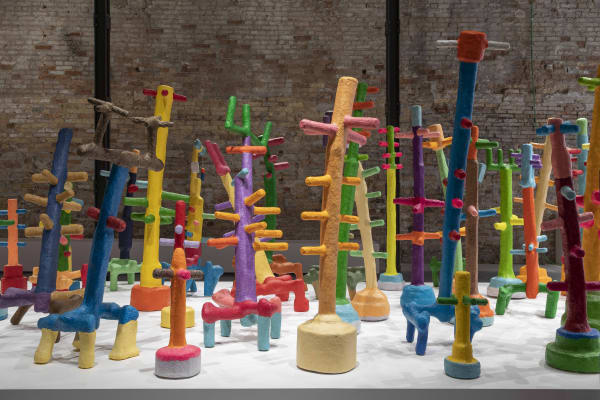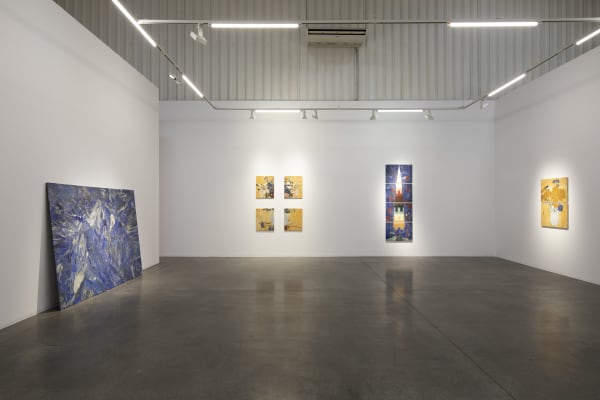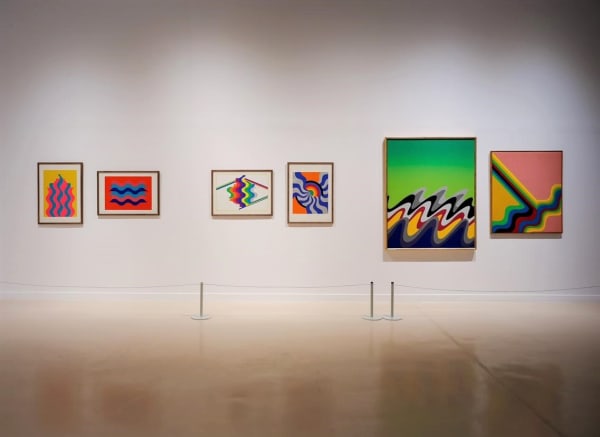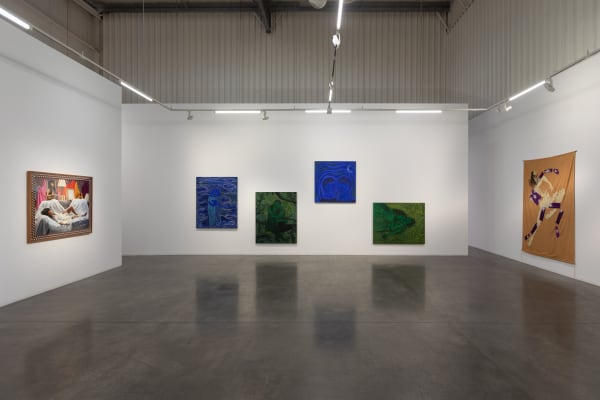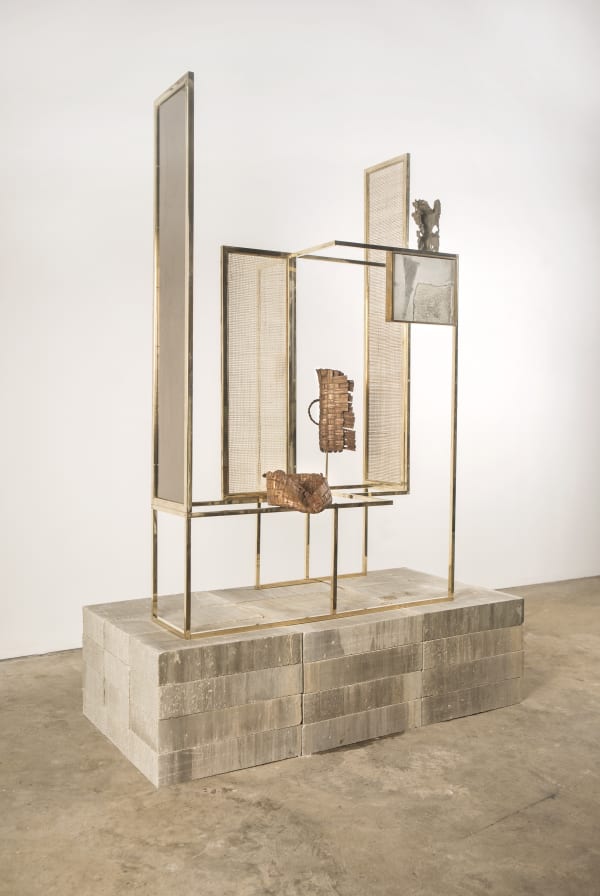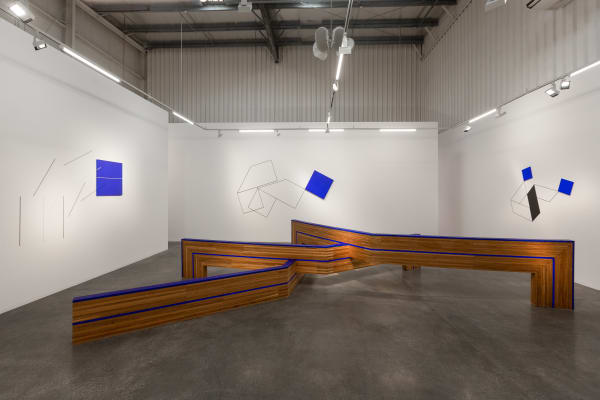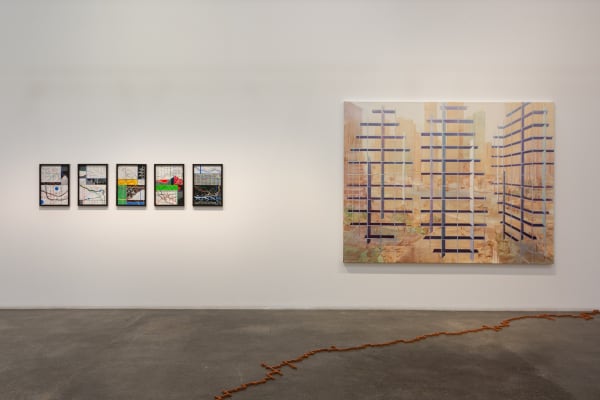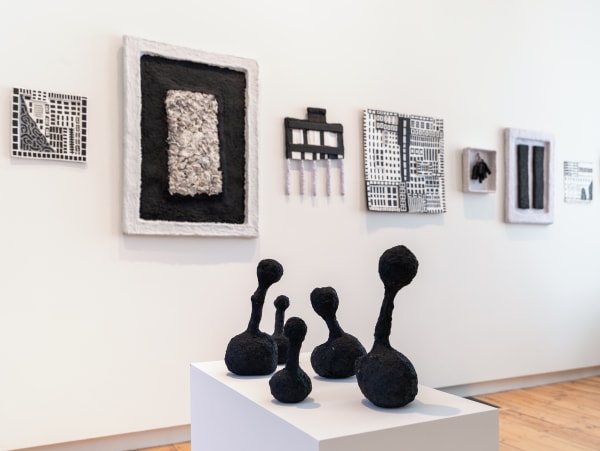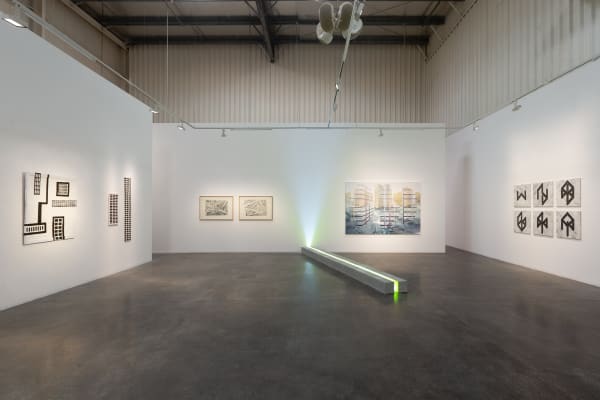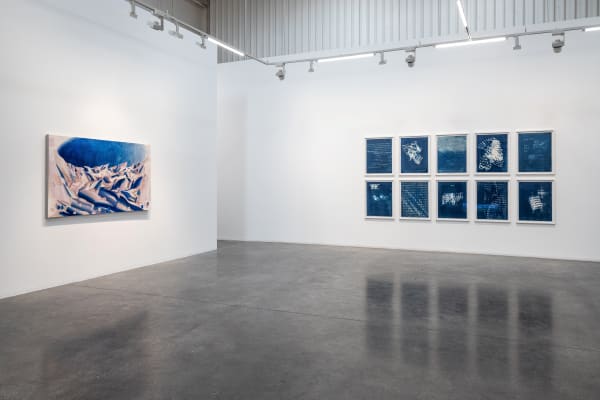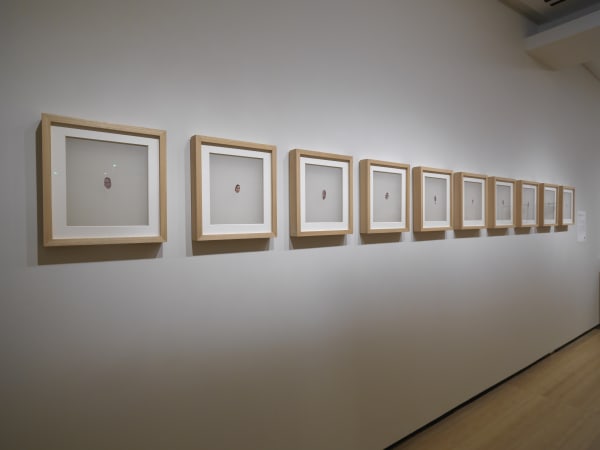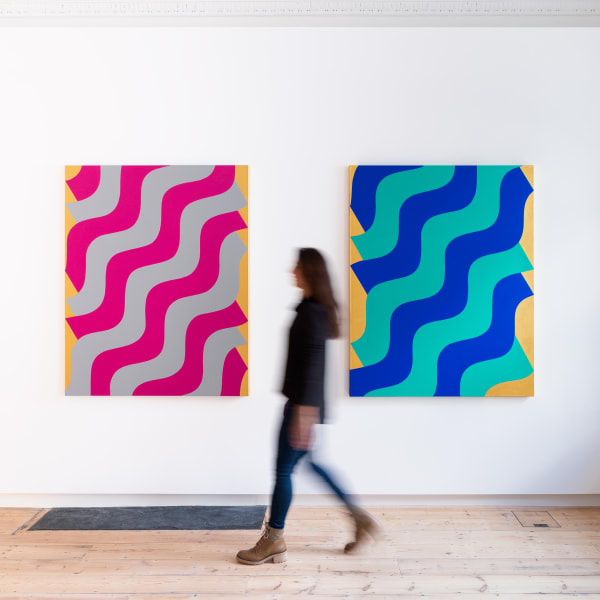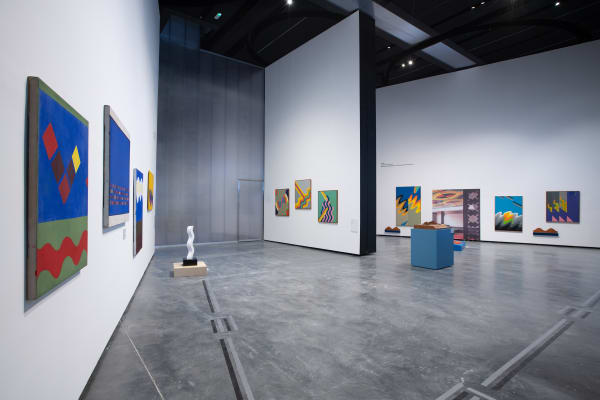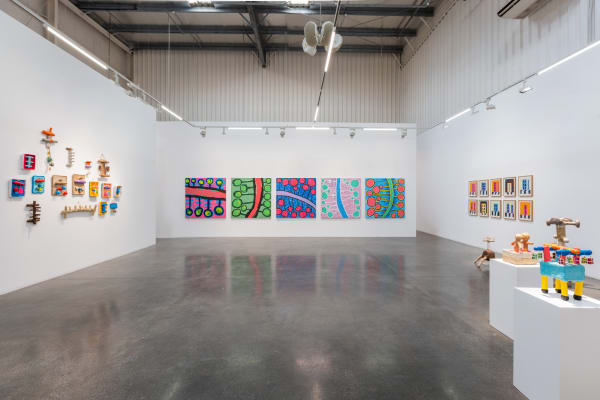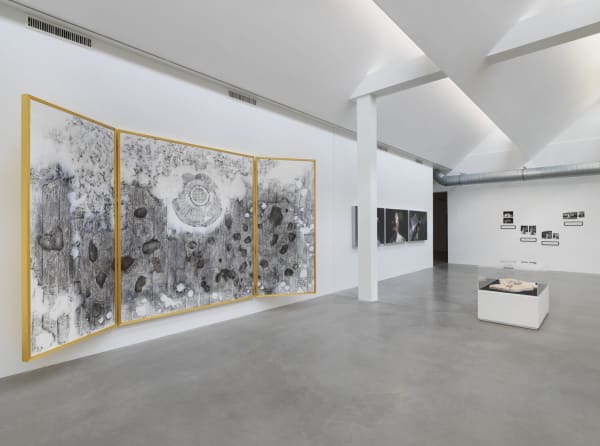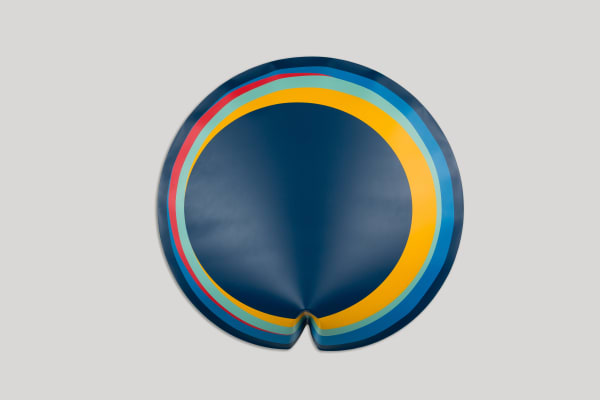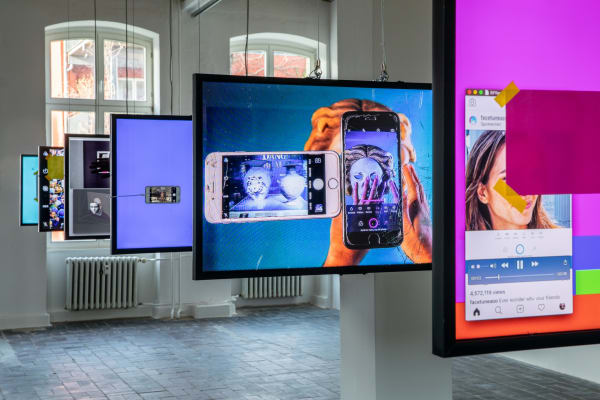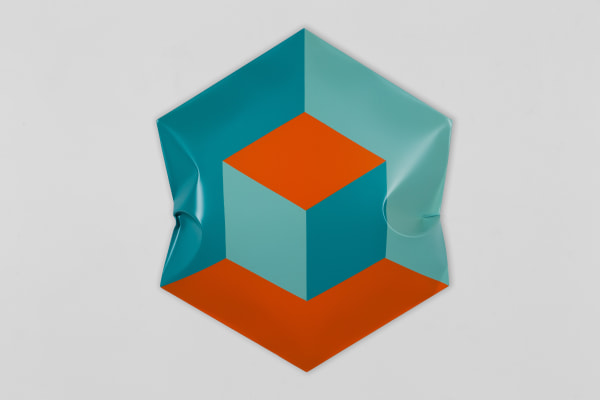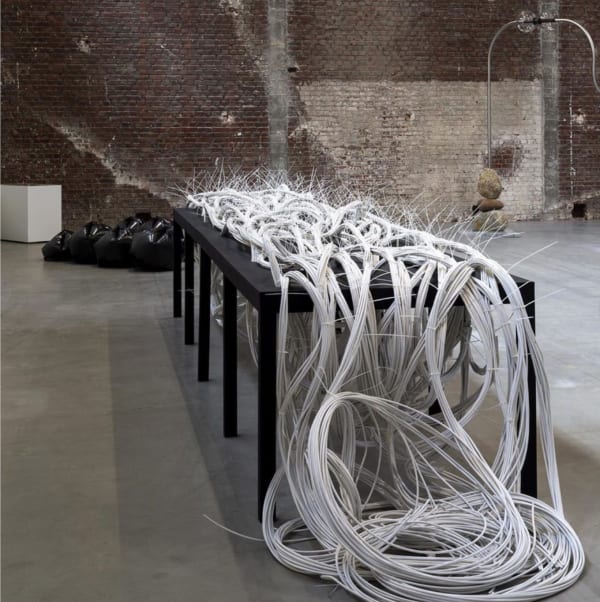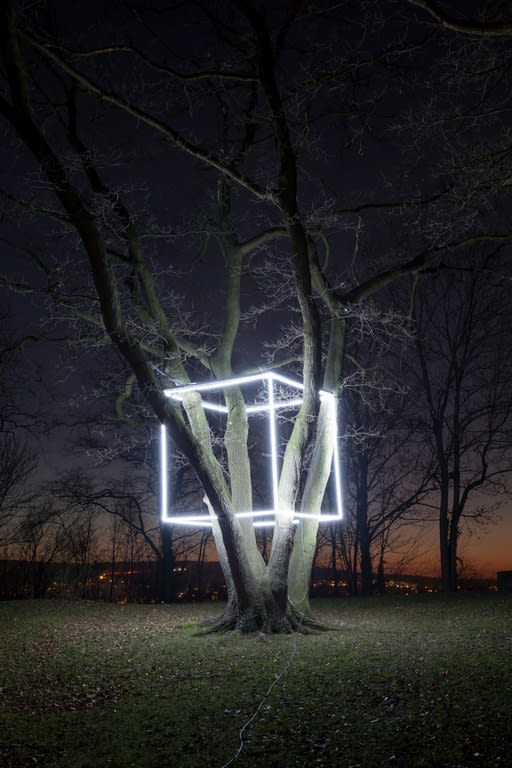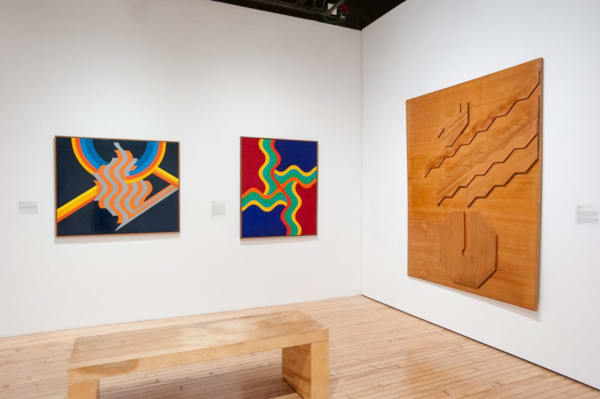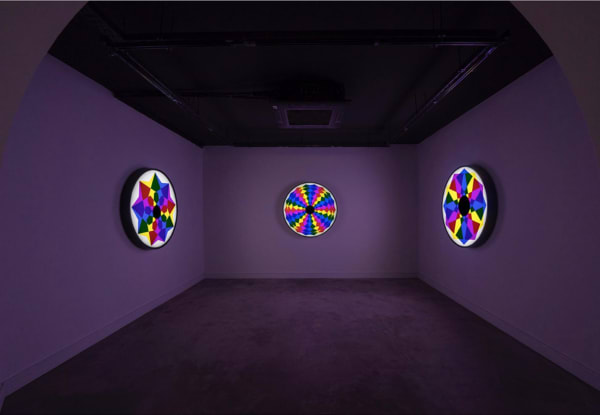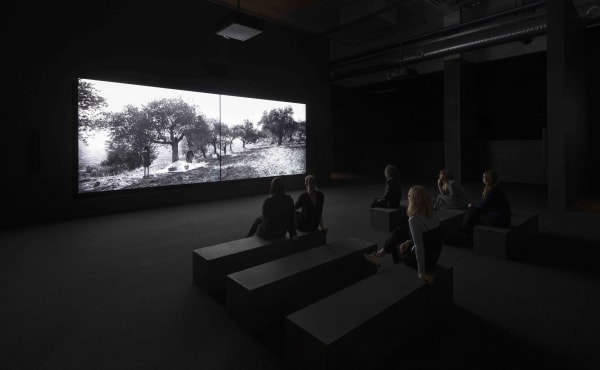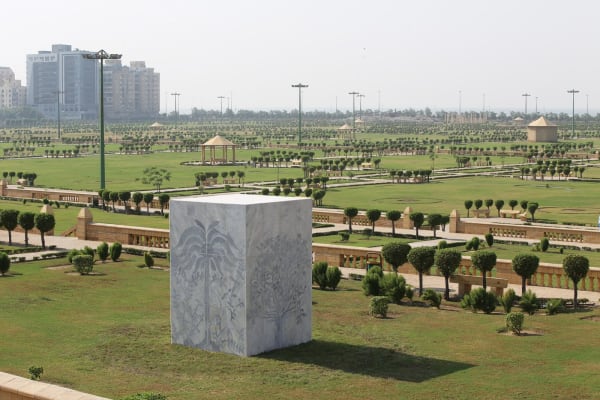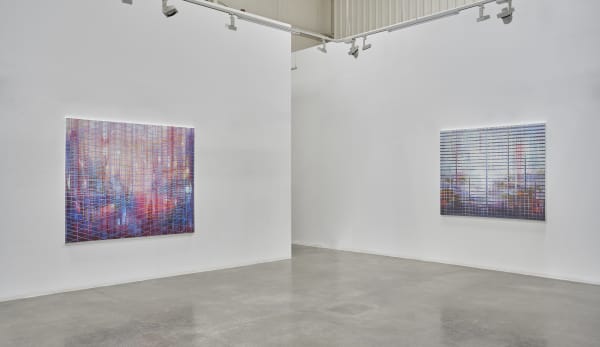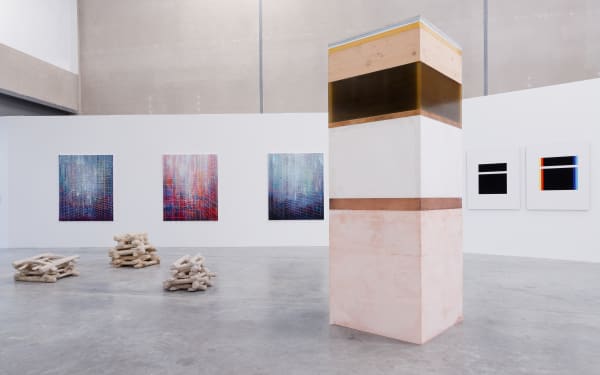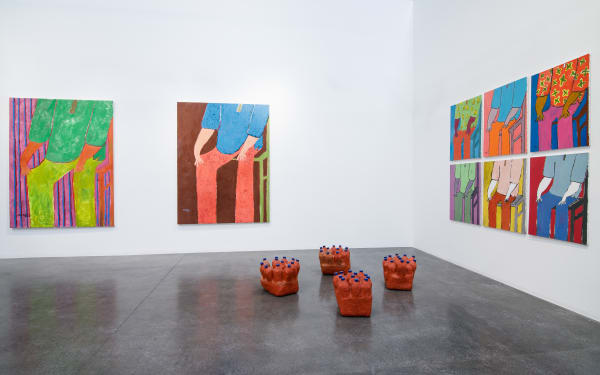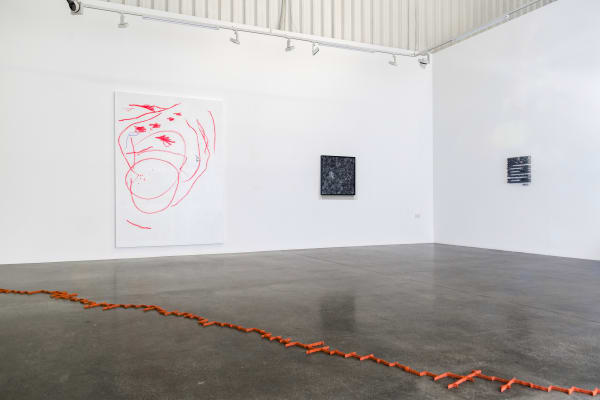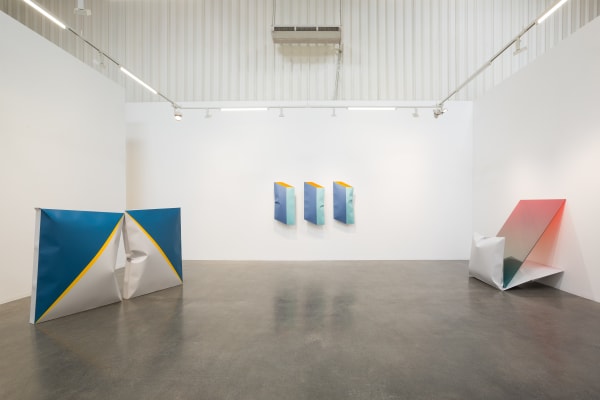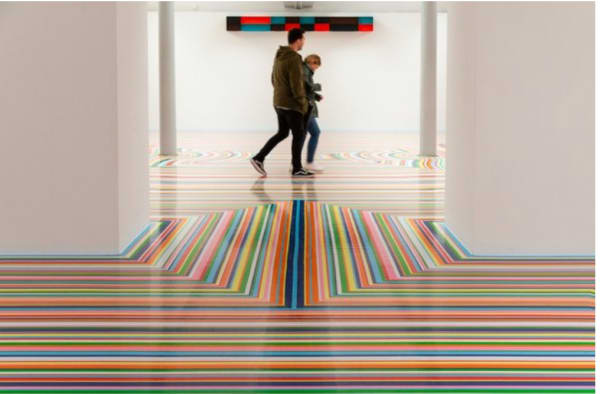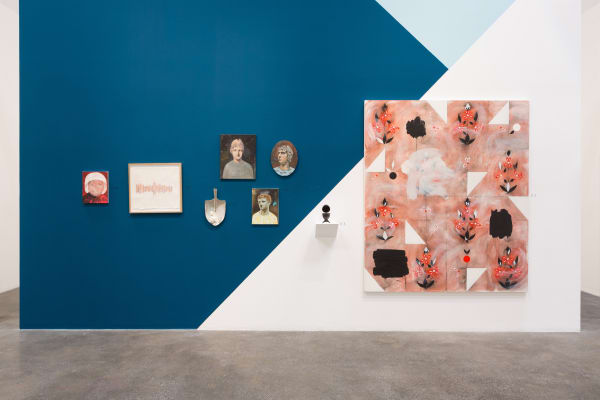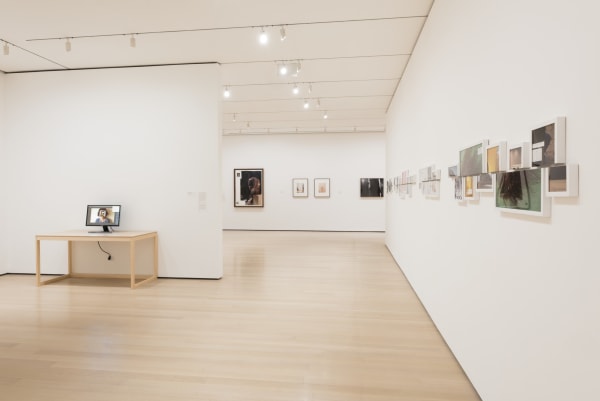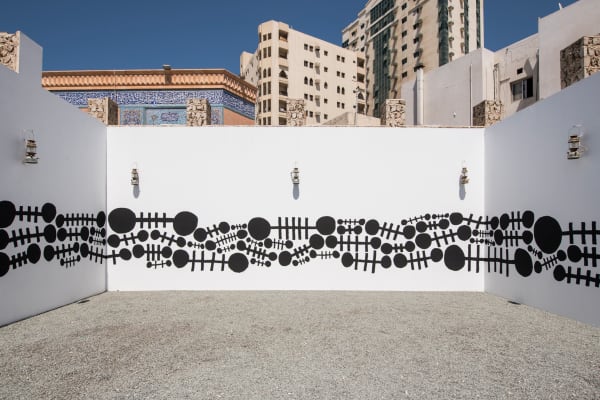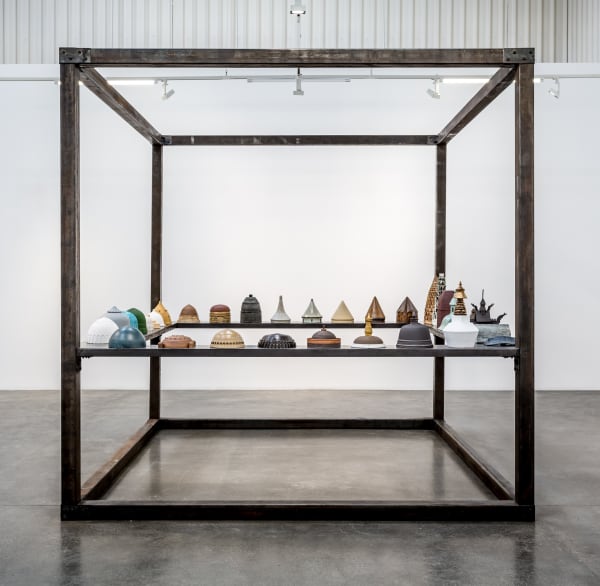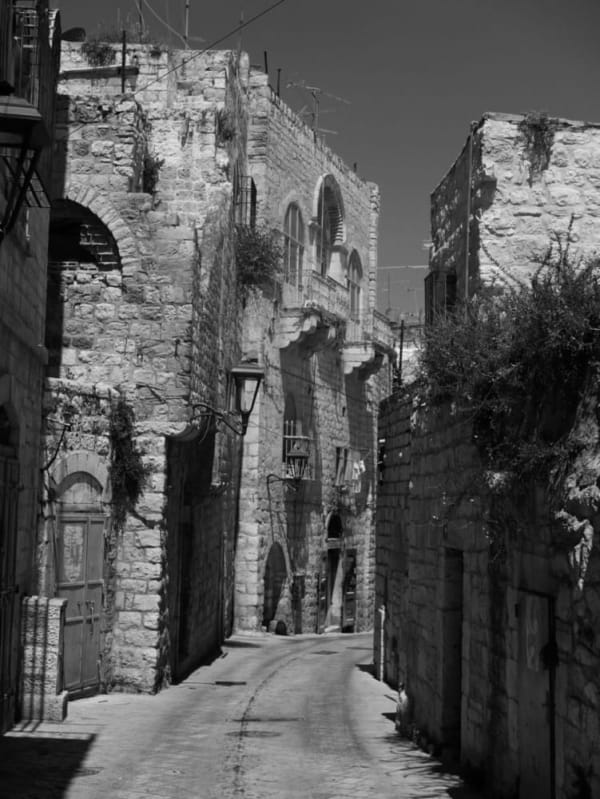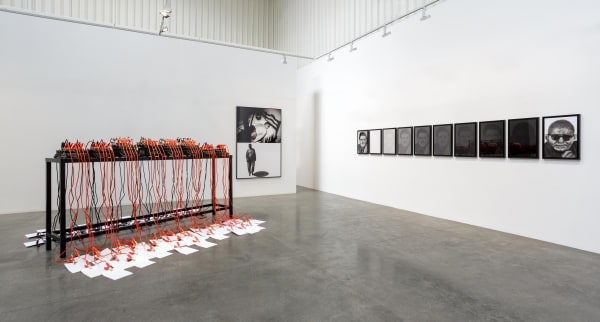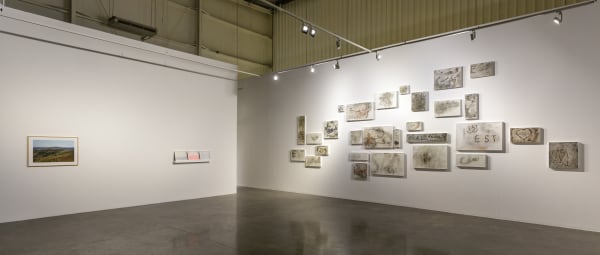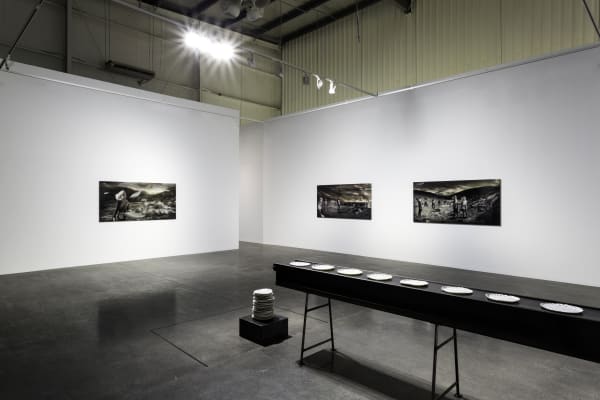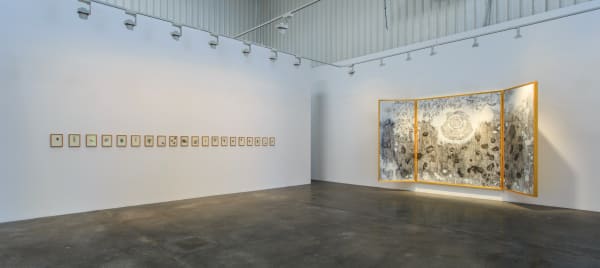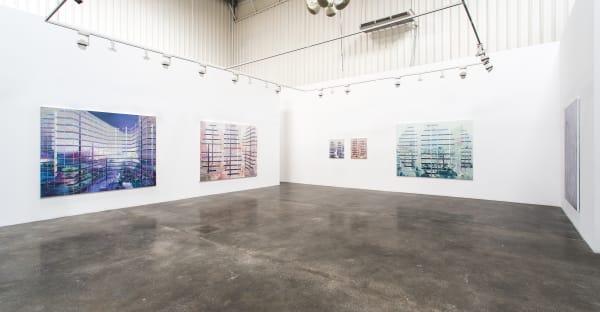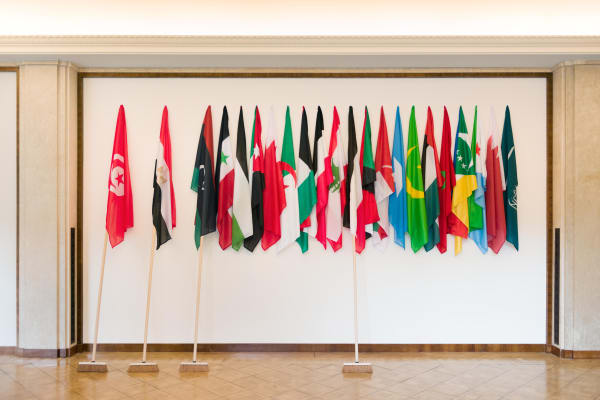Past
-

Mandy El-Sayegh
XXX KISS CROSS KILL 10 - 15 May 2025 Kummelholmen presents the first solo exhibition in Sweden by Mandy El-Sayegh. Based in London, El-Sayegh’s practice is rooted in assemblage, and executed in a wide range of media, including densely layered paintings, sculpture, and installation, as well as performance, sound, and video. Her works investigate the formation and break-down of... Read more -

Elias Sime
THROUGH THE WINDOW - በመስኮቱ ውስጥ 15 Apr - 24 May 2025 Lawrie Shabibi is excited to present Through the Window - በመስኮቱ ውስጥ , the first solo exhibition in the Middle East by Elias Sime, born and based in Addis Ababa. Opening on 15 April 2025 , the exhibition showcases Sime’s distinctive practice of transforming technological materials—colourful wires that he braids,... Read more -

Form and Rhythm
Sotheby's, Dubai in collaboration with Lawrie Shabibi 12 Mar - 7 Jun 2025 Form and Rhythm is an exhibition presented by Lawrie Shabibi at Sotheby’s Dubai, scheduled from March 12 to May 7, 2025. This exhibition is part of The Gallery Collective , a unique two-year partnership between Sotheby’s Dubai and the UAE’s homegrown galleries, which launched in November 2024 with a rotating... Read more -

Mandy El-Sayegh Features in Group Show at BRUTUS, Rotterdam
8 - 15 Mar 2025 Mandy El-Sayegh presents The Body at the exhibition EVERYTHING IS TRUE – NOTHING IS PERMITTED at Rotterdam’s arts center BRUTUS. Split across two distinct yet interlinked levels, The Body creates separate immersive environments that together form a cohesive narrative. One level recreates elements of El-Sayegh’s studio—walls adorned with paintings-in-progress, scattered... Read more -

Yazan Khalili
HAWAI‘I TRIENNIAL 2025 15 Feb - 4 May 2025 Yazan Khalili’s work for HT25 emerges from his deeply engaged artistic and political practice, which interrogates systems of power, representation, and resistance. Against Total Meaning is a project that takes the form of merchandise—sweaters, T-shirts, hoodies, caps, and bucket hats—each emblazoned with fragments of a statement by the artist that... Read more -

Sola Olulode
I’ve Got to Know You Now We May Never Meet Again 4 Feb - 28 Mar 2025 Gallery Lawrie Shabibi is delighted to present I’ve Got to Know You Now We May Never Meet Again , the Dubai debut exhibition by London based Nigerian-British Artist Sola Olulode whose paintings depict a vibrant dialogue between myth, memory, and the sea. In this new series of paintings, the artist draws... Read more -

Shahpour Pouyan Features in Group Exhibition at the Middle East Institute, Washington D. C.
Maximal Miniatures: Contemporary Art from Iran 31 Jan - 23 May 2025 Shahpour Pouyan features in a group exhibition at the Middle East Institute in Washington, D.C., presenting two of his intricate miniature works: Khorsus and Ships Loaded with Treasures (2019) and “After” Muhammad and the Angel of Snow and Fire (2017). Rooted in Persian artistic traditions, Pouyan’s work explores themes of... Read more -

Farhad Ahrarnia
No Scheherazade 14 Dec 2024 - 28 Jan 2025 Gallery Lawrie Shabibi is pleased to announce No Scheherazade by Farhad Ahrarnia, his fourth solo exhibition at the gallery. Comprising works in Ahrarnia’s signature techniques of embroidered photography and wood inlay against an immersive backdrop inspired by Prince’s 1987 video Sign O’ The Times, No Scheherazade is a dissection/celebration of Princess... Read more -

Dima Srouji Features in Group Show at Hayy Jameel
We saw an endless cycle 27 Nov 2024 - 17 Apr 2025 Taking its title from a poem by Seher Shah, We Saw an Endless Cycle explores how artists engage with the city through intimate gestures. Featuring works that reflect acts of walking, crawling, photographing, painting, drawing, sculpting, and counter-mapping, the exhibition traces echoes of these practices across decades and geographies. Together,... Read more -

Mounir Fatmi Features at Biennale de Bamako
Bamako Enounters / Rencontres de Bamako 16 Nov 2024 - 15 Jan 2025 Biennials Mounir Fatmi's photographic triptych Calligraphy of Fire has been selected for this year's Bamako Biennale, where it will be showcased in its large 70 x 105 cm version. The 14th Bamako Encounters – The African Biennal of Photography will be held from November 16, 2024 to January 15, 2025 in... Read more -
Dima Srouji Features in Group Exhibition at Washington Project for the Arts at Gallery 1
93 Fragments 14 Nov 2024 - 15 Feb 2025 93 Fragments is organized by DC-based artist Mojdeh Rezaeipour and hosted by GW’s Corcoran School of the Arts & Design in Gallery 1 at the Flagg Building from November 14, 2024–February 15, 2025. The project includes a group exhibition and a series of programs that bring together the creative practices... Read more -

Mounir Fatmi Features in Group Show at Misk Art Institute
3 Nov 2024 - 27 Feb 2025 The Misk Art Institute’s latest exhibition, The Silent Age of Singularity , brings together the work of 20 visionary artists to examine the profound impact of the internet era on modern communication and the sharing of ideas. This exhibition delves into the subtle yet transformative changes reshaping society, where the... Read more -

Farhad Ahrarnia Features in Group Exhibiton at Qatar Museums
Seeing Is Believing: The Art and Influence of Gérôme 2 Nov 2024 - 22 Feb 2025 Museums 'Seeing Is Believing: The Art and Influence of Gérôme' unfolds across three separate yet interconnected sections, each one presenting, questioning or reevaluating Gérôme’s artistic output through different perspectives, artistic mediums and points in time. The exhibition is organised by the future Lusail Museum in collaboration with Mathaf: Arab Museum of... Read more -
Hamra Abbas Features in exhibition at the National Museum of Qatar
MANZAR: Art and Architecture from Pakistan 1940s to Today 1 Nov 2024 - 31 Jan 2025 Hamra Abbas will present a selection of her works, including Porters 2 (2024) and Flowers: Gardens of Paradise (2020), at the upcoming exhibition *MANZAR: Art and Architecture from Pakistan 1940s to Today*. The latter piece, Flowers: Gardens of Paradise , was specifically commissioned for Manzar and is now part of... Read more -

Rand Abdul Jabbar
Molding Anew 31 Oct - 6 Dec 2024 Gallery Curated by Meitha Almazrooei Exhibition Designed by Alejandro Stein. Lawrie Shabibi, Dubai, is pleased to present Molding Anew, Rand Abdul Jabbar's first solo exhibition at the gallery. The exhibition builds on her recent commission for Desert X Alula, where myths are born of mud and desire (2024), staging an interplay... Read more -

Monir Fatmi at Bienal Internacional de Poesía Experimental de Argentina - POSVERSO
18 Oct - 20 Dec 2024 POSVERSO is a biennial focused on the multiple practices of intersemiotic poetry, which is generated by Hotel DaDA Base of Mail Art and Experimental Poetry, in the city of Junín, northwest of the province of Buenos Aires. Mounir Fatmi will present his installation Inside the fire circle 02 at POSVERSO.... Read more -
Yazan Khalili Featured in Group Exhibiton at Wende Museum
Counter/Surveillance: Control, Privacy, Agency 13 - 19 Oct 2024 The exhibition Counter/Surveillance traces the historical roots of such surveillance devices and methods, and the Cold War dynamics that shaped and spread them. It explores the precursors of current biometric surveillance in Cold War manuals for police, border guards and spies; in forensic portraiture; and in the little-known early history... Read more -
Shahpour Pouyan at the Johnson Museum of Art
Winter in Paradise: Johnson Museum of Art 10 - 15 Oct 2024 This exhibition marks the second showcase of Shahpour Pouyan's art in the United States. Winter in Paradise is funded and sponsored by the Frist Art Museum and the Foundation for Contemporary Arts and was the recipient of the 2022 Ellsworth Kelly Award in Visual Arts. Following a successful run at... Read more -

Shaikha Al Mazrou and Mohamed Ahmed Ibrahim To Feature at Bassam Freiha Art Foundation
Hour Eternal - Emirati Abstraction 10 Oct 2024 - 15 Feb 2025 Curated by Dr. Michaela Watrelot, Hour Eternal - Emirati Abstraction will feature 14 Emirati artists who have played a role in shaping contemporary art in the Emirates, with works on loan from the Ministry of Culture, artists’ studios and galleries, and private collectors. Abstract art has evolved significantly over the... Read more -
Mohamed Ahmed Ibrahim Takes Part in Group Exhibition at Al Safa Art & Design Library
Narratives of Belonging 25 Sep - 18 Oct 2024 Mohamed Ahmed Ibrahim participates in the group exhibition ‘Narratives of Belonging’at Al Safa Art & Design Library– a celebration of Emiratis who have laid the foundation of the cultural and creative landscape in the region and defined the voice of the Arabic creative, as well as those who continue to... Read more -
![Alia Ahmad: 'Aspects [مظاهر]'](data:image/gif;base64,R0lGODlhAQABAIAAAAAAAP///yH5BAEAAAAALAAAAAABAAEAAAIBRAA7)
Alia Ahmad: 'Aspects [مظاهر]'
18 Sep - 22 Oct 2024 Gallery Lawrie Shabibi is pleased to announce the first solo exhibition in the UAE of Saudi Arabian artist Alia Ahmad. Aspects [ مظاهر] , presenting a new body of paintings and watercolours. She seeks, in Aspects to peel back the layers in order to expose her personal vocabulary. Ahmad’s point of... Read more -
Mounir Fatmi at Colorado Springs Fine Arts Center at Colorado College
ALHAMDU - MUSLIM FUTURISM 13 Sep 2024 - 11 Jan 2025 Curated by Yusuf Siddiquee ALHAMDU - MUSLIM FUTURISM at Colorado Springs Fine Arts Center will feature two works by Mounir Fatmi; Mixology (2010) and Modern Times (2010). ALHAMDU | MUSLIM FUTURISM is an evolving multidisciplinary exhibition and archive created by MIPSTERZ featuring a variety of work from paintings, photography, illustrations... Read more -

Asad Fauwell Featured at Wellin Museum Exhibition
Menagerie: Animals in Art from the Wellin Museum 7 Sep 2024 - 25 Jun 2025 From the ancient world through to the present day, ' Menagerie' curated by Elizabeth Shannon, PhD, Collections Curator, explores how humans have utilized animal iconography across all areas of cultural production and encourages a thoughtful and conscious understanding of the presence of animals in our everyday lives. The exhibition presents... Read more -

Timo Nasseri at San Diego Museum of Art
Wonders of Creation: Art, Science, and Innovation in the Islamic World 7 Sep 2024 - 5 Jan 2025 Wonders of Creation explores intersections of art and science in Islamic intellectual and visual culture from the 8th century to the present day, using the lens of “wonder” as defined by a celebrated 13th-century Islamic cosmography, an influential text describing the wonders of the universe. Using wonder as the vehicle... Read more -

Augustine Paredes: Artist's Room at Jameel Arts Centre
8 Jul - 24 Aug 2024 Augustine Paredes’ artist’s room at Jameel Arts Centre brings together his own personal histories and stories that explore his relationship to identity and family. Focusing on his personal journey as a migrant – constantly navigating between time, places and identities – the works delve into the complexities of his own... Read more -

Shahpour Pouyan to Exhibit First Solo Museum Show in the US: 'Winter in Paradise'
Curated by Trinita Kennedy 30 May - 25 Aug 2024 Museums Shahpour Pouyan is set to exhibit his largest solo museum exhibition to date, and first solo museum show in the US, Winter in Paradise, at the Frist Art Museum, Nashville, Tennessee, on May 30th (curated by Trinita Kennedy). Presented across three galleries, the exhibition explores architectural symbols of power and... Read more -

Dima Srouji: 'Charts for a Resurrection'
7 May - 20 Jul 2024 Gallery Lawrie Shabibi is delighted to announce the first-ever solo exhibition for artist, architect and researcher Dima Srouji titled Charts for a Resurrection, on view 7 May - 20 July 2024. Srouji’s work lies in the expanded context of interdisciplinary research projects. It acts as a form of political commentary and... Read more -

Mohamed Melehi | La Biennale di Venezia
STRANIERI OVUNQUE - FOREIGNERS EVERYWHERE 20 Apr - 24 Nov 2024 Biennials Mohamed Melehi participates in the group exhibition 'Stranieri Ovunque - Foreigners Everywhere', featured in the 60th International Art Exhibition of La Biennale di Venezia, curated by Adriano Pedrosa. The 60th International Art Exhibition of La Biennale di Venezia takes its title from a series of artworks initiated in 2004... Read more -

Mona Saudi, Mohamed Melehi, and Mehdi Moutashar | The Musée d'Art Moderne de Paris
Group Exhibition 5 Apr - 25 Aug 2024 Museums Lawrie Shabibi artists Mona Saudi, Mohamed Melehi, and Mehdi Moutashar works are being showcased at the Musée d'Art Moderne de Paris, in the group exhibition 'Arab Presences Modern Art and Decolonisation: Paris 1908-1988'. The exhibition features a selection of over 200 works (most of which have never been exhibited before... Read more -

Driss Ouadahi at Von der Heydt Museum in Wuppertal, Germany
24 Feb - 1 Sep 2024 Museums Driss Ouadahi's work is exhibited at the 'Not much to look at. Ways of Abstraction 1920 Until Today' group show at the Von der Heydt Museum in Wuppertal, Germany. The Von der Heydt Museum has unveiled a group exhibition with a focus on abstraction: from classical modernism to current trends... Read more -

Dima Srouji at Doha Design Biennale 2024
'Arab Design Now’, curated by Rana Beiruti 24 Feb - 25 Aug 2024 Biennials Dima Srouji participates in the headline exhibition for Design Doha: 'Arab Design Now'. The exhibition is curated by Rana Beiruti, a design curator based in Amman, Jordan, and previously the co-founder and director of Amman Design Week. 'Arab Design Now' presents a survey of local and regional design talent across... Read more -

Mandy El-Sayegh: A rose is a rose is a rose is a rose
22 Feb - 4 Apr 2024 Gallery In collaboration with sound artist Sami El-Enany and movement artist Chelsea Gordon Curated by Sara Raza A rose is a rose is a rose is a rose is London-based artist Mandy El-Sayegh ’ s inaugural solo exhibition in Dubai. The site-specific exhibition, encompassing painting, installation, video, sound, and performance, operates... Read more -

Timo Nasseri at the Saudi Arabia Museum of Contemporary Art (SAMoCA)
16 Jan - 20 May 2024 Museums Timo Nasseri takes part in ‘In the Night’, curated by Géraldine Bloch, at the Saudi Arabia Museum of Contemporary Art (SAMoCA) in the Jax District in Riyadh. The night, often a sanctuary for artists and poets, serves as a canvas for imagination, introspection, and observation. ‘In the Night’ invites visitors... Read more -

Ishmael Randall-Weeks: Desert Displacements
11 Jan - 9 Feb 2024 Gallery Lawrie Shabibi is pleased to present the second solo exhibition by Peruvian artist Ishmael Randalll-Weeks at the gallery. The exhibition, which runs from 11 January – 9 February 2024, transforms fundamental geometric models into objects echoing the poetry of utility. Each of the artworks showcased weaves through the domains of... Read more -

Mounir Fatmi at the Pola Museum of Art in Japan
16 Dec 2023 - 19 May 2024 Museums Mounir Fatmi participates in the group exhibition 'Modern Times in Paris 1925 - Art and Design in the Machine Age', curated by Yo Shoji at the Pola Museum of Art, Hakone, Japan. This exhibition introduces aspects of the relationship between machines and humans in Europe, America, and Japan, with... Read more -

Augustine Paredes, Solo Exhibition | 'Yearning The Sun To Fall', Fffriedrich, Frankfurt
Curated by Anna Bernice delos Reyes 3 - 17 Dec 2023 For his first solo show in Germany, Augustine Paredes presents Yearning the Sun to Fall, featuring new works developed in his studio in Frankfurt. In this exhibition, Augustine embodies the Greek myth of Icarus as a way to understand the plight of the brown migrant body. In the Greek myth,... Read more -

NABIL NAHAS: TETHYS
Solo Exhibition 30 Oct 2023 - 5 Jan 2024 Gallery Tethys is the third solo exhibition by the renowned Lebanese American artist Nabil Nahas at Lawrie Shabibi, taking viewers on a journey through the boundless world of colour, texture, and imagination. This exhibition coincides with the gallery's reopening and will be on view from 30 October to 5 January 2024.... Read more -

'Mehdi Moutashar: Introspection as Resistance' at Mathaf, Arab Museum of Modern Art
Curated by Amin Alsaden 26 Oct 2023 - 4 May 2024 Museums Mehdi Moutashar has been experimenting in geometric abstraction over a remarkable career that spans five decades. Exquisitely controlled, his works are almost scientific in their mathematical precision. Despite this exactitude, however, the artist’s practice equally conveys spontaneous and fleeting moments from his youth, when he witnessed mesmerising ornamentation in local... Read more -

Yazan Khalili & Mohamed Ahmed ibrahim in 'Unwritten, Unspoken & Told' Exhibition
Group exhibition at Foundry Downtown as part of Dubai Calligraphy Biennale 8 - 31 Oct 2023 Dubai Culture and Arts Authority (Dubai Culture) is introducing fresh and cutting-edge expressions of contemporary art from both local and international artists in the Unwritten, Unspoken & Told exhibition. This is a key feature of the inaugural Dubai Calligraphy Biennale, held under the patronage of His Highness Sheikh Hamdan bin... Read more -

Dima Srouji at London Design Festival
Spaces within the V&A Museum will be transformed by a collection of specially commissioned installations 16 - 24 Sep 2023 Museums During London Design Festival's 21st edition Palestinian architect, artist and V&A 2022-23 Jameel Fellow Dima Srouji presents objects and film that reframe the history of glass in Greater Syria and Palestine. The new works part of her project 'But She Still Wears Kohl and Smells like Roses’ include replicas of... Read more -

Augustine Paredes, solo exhibition | 'Light, Leaks', Foundry, Dubai
2 - 29 Sep 2023 'Light, Leaks' is Augustine Paredes second solo show in the UAE that explores accidental anomalies, triggering memories of flawed pictures and contemplations of the essence of light. Inspired by an archive of failed images, Augustine begins his process by initially painting a figure, then smearing several layers of oil paint... Read more -

Mohamed Ahmed Ibrahim at the Bihar Museum
G20: Together We Art 7 Aug - 7 Oct 2023 Museums Together we art is based on the theme of Vasudhaiva Kutumbakam, a concept from the Maha Upanishad. Art reflects society, the concerns of community, from the political, to the cultural, from the traditional to the modern and finally to the contemporary. The world of art, of imagination, of creative expression... Read more -

Christie's London: Modern and Contemporary Art of the Arab World
Group Exhibition 20 Jul - 23 Aug 2023 Museums Christie’s presents Modern and Contemporary Art of the Arab World, bringing together works of art across mediums in an exhibition which collectively celebrates the creativity, diversity and history of Arab Art. The exhibution is organised in two distinct sections, Kawkaba: Highlights from the Barjeel Art Foundation, features artworks by Mohamed... Read more -

Mona Saudi & Mohamed Ahmed Ibrahim at Sharjah Art Foundation
In the Heart of Another Country: The Diasporic Imagination Rises 15 Jul - 24 Sep 2023 Museums We are pleased to announce that works by Mona Saudi and Mohamed Ahmed Ibrahim are currently part of 'In the Heart of Another Country: The Diasporic Imagination Rises', curated by Dr Kholeif and presented across all six galleries in Al Mureijah Square, Sharjah Art Foundation, from July 15 to September... Read more -

Mohamed Melehi: The Casablanca Art School at Tate St Ives
Group Exhibition 27 May 2023 - 14 Jan 2024 Museums Tate St Ives is the first museum in the UK to explore the intense period of artistic rebirth that followed Morocco’s independence, forged by the experimental teaching methods of the Casablanca Art School in the 1960s and 1970s.'The Casablanca Art School' exhibition features artworks by pioneering artists Mohamed Melehi ,... Read more -

Hamra Abbas at the Misk Art Institute
Group Exhibition 15 Mar - 15 Jun 2023 Hamra Abbas takes part in the ‘Brand New Ancients’ group exhibition on view at Misk Art Institute in Riyadh, KSA. Read more -

Timo Nasseri: All Borrow Their Light
Solo Exhibition 28 Feb - 5 May 2023 Gallery Lawrie Shabibi presents All Borrow Their Light , the first solo exhibition of Berlin-based Timo Nasseri at the gallery. Offering a comprehensive glimpse into Nasseri's oeuvre, the exhibition comprises a carefully curated selection of paintings and sculptures from various stages of the artist’s practice that contemplate concepts of mathematical and... Read more -

Augustine Paredes | 'The Bitter Taste of Sweetness', AlUla, Saudi Arabia
18 Feb - 18 Mar 2023 The Bitter Taste of Sweetness is a site-specific installation completed during Augustine Paredes's AlUla Artist Residency in 2022 and supported by the Royal Commission of AlUla in the Kingdom of Saudi Arabia. Integral to the work is a first-person story about a farmer-labourer hired by a farm owner looking to... Read more -

Larry Amponsah: The Soil From Which We Came
Solo Exhibition 11 Jan - 17 Feb 2023 Gallery Lawrie Shabibi presents The Soil From Which We Came , the first solo exhibition of Larry Amponsah (b. 1989, Ghana) in the UAE. The exhibition continues the artist’s experimentation, reconfiguration and modification of archival imagery through collage and painting, in order to evoke a deeper awareness of interconnectivity and focus... Read more -

Shaikha Al Mazrou: Dwelling in the Gap
Solo Exhibition 14 Nov 2022 - 5 Jan 2023 Gallery Dwelling in the Gap is Shaikha Al Mazrou’s second solo exhibition at Lawrie Shabibi. Here Al Mazrou develops the forms and language of her practice, and extends her investigations into materiality, tension and the interplay between structure and content. Her materials appear to betray their functions and their fixed properties.... Read more -

Shahpour Pouyan at the Hayward Gallery
Strange Clay: Ceramics in Contemporary Art 26 Oct 2022 - 8 Jan 2023 Museums Featuring 23 international artists working across recent decades, the exhibition examines the plasticity and the possibilities of ceramics. The artworks on show encompass fantastical creatures and uncanny representations of the everyday, as well as ranging from small abstract works to large-scale installations that take the medium beyond the kiln. The... Read more -

Nathaniel Rackowe: Fractured Landscapes
Solo Exhibition 22 Sep - 4 Nov 2022 Gallery Fractured Landscapes is the third solo exhibition by London-based artist Nathaniel Rackowe (b. 1975, UK) to be shown at the gallery. Rackowe’s practice spans public art, installation, sculpture, contemporary dance and painting; investigating form and materiality through his observations of light and the effect its changeability has on our experiences... Read more -

TAKING SHAPE: ABSTRACTION FROM THE ARAB WORLD, 1950S – 1980S
Mohamed Melehi and Maliheh Afnan at the Block Museum of Art, United States 22 Sep - 4 Dec 2022 Museums Block Museum of Art, Northwestern University will present Taking Shape: Abstraction from the Arab World, 1950s–1980s , a groundbreaking exhibition drawn from the collection of the Barjeel Art Foundation based in Sharjah, United Arab Emirates. The exhibition explores mid-20th-century abstract art from North Africa, West Asia, and the Arab diaspora,... Read more -

Mohamed Ahmed Ibrahim: Embryonic Coat
Solo Exhibtion 18 May - 16 Jul 2022 Gallery Embryonic Coat is the third solo exhibition by Mohamed Ahmed Ibrahim (b. 1962, UAE) to be shown at the gallery. Here Ibrahim explores the conception or manifestation of the known, experienced, or imagined, as contained within rudimentary forms. The title references the protective sheath around a seed or the membrane... Read more -

Mohamed Ahmed Ibrahim: Between Sunrise and Sunset
Biennale di Venezia 2022 23 Apr - 27 Nov 2022 Biennials The National Pavilion UAE’s exhibition at the Biennale Arte 2022 (Venice Biennale) is titled Mohamed Ahmed Ibrahim: Between Sunrise and Sunset. The exhibition presents a new body of work created for the National Pavilion UAE by Emirati artist Mohamed Ahmed Ibrahim, a veteran of the experimental art community in the... Read more -

Hamra Abbas: COLOR | GARDEN
Solo Exhibition 8 Mar - 7 May 2022 Gallery COLOR | GARDEN is the forth solo exhibition of Hamra Abbas (b. 1976, Kuwait) at the gallery, presenting a set of conceptual prints alongside new marble inlay works that extend her investigation of color theory, geometry and the garden motif in architecture. The show coincides with her EXPO 2020 Dubai... Read more -

Diriyah Contemporary Art Biennale: Feeling the Stones
Mohamed Melehi at the inaugural edition of the Diriyah Biennale 11 Dec 2021 - 11 Mar 2022 Biennials The Diriyah Contemporary Art Biennale features a historic collection of jubilant works by Mohamed Melehi, a major figure in postcolonial Moroccan art and modernism in the global south. Read more -

Run With The Wolves
Group Exhibition 30 Nov 2021 - 1 Mar 2022 Gallery Run With The Wolves - an exhibition featuring five contemporary women artists - explores mythology, identity, gender and sexuality through figuration as the central motif. The show takes its title from the book Women who Run with the Wolves - Myths and Stories of the Wild Woman Archetype by Clarissa... Read more -

Ishmael Randall Weeks: Formas Desplazadas (Displaced Forms)
Solo Exhibition 12 - 17 Oct 2021 Lawrie Shabibi presents Formas Desplazadas ( Displaced Forms ) - Lima-based sculptor Ishmael Randall Weeks’ (b. 1976, Cusco) first solo exhibition in London. In his works Randall Weeks modifies industrial and organic materials, and environmental debris (concrete, clay, copper, steel, discarded books, glass) to create sculptural objects and architectural spaces... Read more -

Mehdi Moutashar: Cardinal Points
Solo Exhibition 5 Oct - 24 Nov 2021 Gallery Cardinal Points - French-Iraqi artist Mehdi Moutashar's first solo at the gallery - presents a curation of contemporary artworks and a large-scale installation that are quintessential to his practice, celebrating Moutashar as a meeting point between Islamic tradition and experimental optical art. Born in Iraq in 1943, Moutashar spent most... Read more -

Under Construction Part II
Group Exhibition 5 Jul - 22 Sep 2021 Gallery Under Construction Part II expands on the notion of the uncompleted project, the work in progress, presenting a series of evolving, paradoxical, overlapping paradigms, where histories are re-evaluated, cultural artefacts re-examined, and multiple futures are explored. Works by Farhad Ahrarnia (b. 1971, Iran), Mounir Fatmi (b. 1970, Morocco), Mohamed Ahmed... Read more -

Mohamed Ahmed Ibrahim: Dusk Till Dawn
Solo Exhibition 2 - 13 Jun 2021 Gallery Dusk Till Dawn is Emirati artist's Mohamed Ahmed Ibrahim first solo exhibition in London, taking place at Cromwell Place, as part of a wider collaboration between Abu Dhabi Art, Cromwell Place and a selection of UAE galleries. Ibrahim’s practice is inspired by his deep connection to the natural environment of... Read more -

Under Construction
Group Exhibition 31 May - 26 Jun 2021 Gallery Under Construction , a group exhibition held in two parts, presents a series of incomplete, evolving, overlapping, paradoxical concepts - building structures, formulating symbols, manufacturing appearance, fabricating histories and reconstituting anatomies. The first iteration features works by Hamra Abbas (b. 1976, Kuwait), Mounir Fatmi (b. 197, Morocco), Mohamed Ahmed Ibrahim... Read more -

Boundary Space
Ishmael Randall Weeks 22 Mar - 22 May 2021 Ishmael Randall Weeks (b. 1976, Peru) makes his sculptures and two-dimensional works from adobe, mineral substrates, rattan screens, mud, glass and metal. They constitute a world that emerges from history and memory, navigating between the contemporary, the archaic, tradition and folklore. Often taking the visual form of functional objects, they... Read more -

Farhad Ahrarnia: The Lacemaker
Solo Exhibition 20 Jan - 7 Mar 2021 Gallery The Lacemaker is the third solo exhibition of Farhad Ahrarnia (b. 1971) at the gallery. Comprising images drawn from a diverse range of sources and media – the internet, printed or painted material, and composed with embroidery, painted metalwork and grooming items – the exhibition gives new insight into this... Read more -

Blue
Group Exhibition 21 Nov 2020 - 12 Jan 2021 Gallery Blue explores the dialectic between meaning and visual sensation. Saturated with meanings - freedom, intuition, imagination, expansiveness, inspiration, sadness, faith, spirituality, wisdom, peace, serenity, ethereality, infinity to name just a few - blue has more complex and contradictory connotations than any other colour. Always among the most costly, scarce and... Read more -

We Do Not Dream Alone: Asia Society Triennial
Hamra Abbas 27 Oct 2020 - 7 Feb 2021 Biennials The inaugural Asia Society Triennial, a festival of art, ideas, and innovation, is slated to run October 27, 2020 through June 27, 2021. Featuring 40 artists and 18+ commissioned works, t his first edition of the Asia Society Triennial, titled We Do Not Dream Alone , will be composed of... Read more -

Arabian Moucharabieh
Mohamed Melehi at Cromwell Place London 5 - 11 Oct 2020 Gallery Arabian Moucharabieh is a solo exhibition of new paintings by Moroccan artist Mohamed Melehi (b.1936), presented as part of the inaugural programme of exhibitions taking place at Cromwell Place London. Melehi is regarded as a major figure for postcolonial Moroccan art and of modernism in the Global South. Professor of... Read more -

New Waves: Mohamed Melehi and the Casablanca Art School Archives
Mohamed Melehi at Concrete, Alserkal Avenue 19 Sep - 21 Nov 2020 Alserkal Arts Foundation presents New Waves: Mohamed Melehi and the Casablanca Art School Archives. Curated by Morad Montazami, Zamân Books & Curating, the exhibition retraces the life and career of Melehi the painter, photographer, muralist, graphic designer, art teacher, and cultural activist. New Waves is organised in collaboration with the... Read more -

Mohamed Ahmed Ibrahim: Memory Drum
Solo Exhibition 19 Sep - 12 Nov 2020 Gallery Memory Drum is the second solo exhibition of Mohamed Ahmed Ibrahim (b.1962) at the gallery, comprising a series of new paintings and sculptures, produced during his time in isolation in his Khorfakkan studio during the 2020 lockdown. In psychology, Memory Drum is a theory that unconscious neural patterns acquired from... Read more -

The Invented History
Nadia Kaabi-Linke and Larissa Sansour at KINDL – Centre for Contemporary Art, Berlin 13 Sep 2020 - 21 Feb 2021 Museums Curated by Kathrin Becker, as part of Berlin Art Week 2020, The Invented History is a group exhibition that examines the need to critically question historical narratives. History is no longer viewed as a mere collection of data and facts, as a linear sequence of clearly defined events. Instead, there... Read more -

Paulo Cunha e Silva Art Prize
Shaikha Al Mazrou at Galeria Municipal do Porto, Portugal 12 Sep - 12 Nov 2020 Museums The Paulo Cunha e Silva Art Prize was created in 2015, by Porto City Council, as a tribute to the former Councilor for Culture, Paulo Cunha e Silva, and is aimed at artists under 40 years of age. The jury of the second edition of the award – Isabel Lewis,... Read more -

Miniature 2.0
Hamra Abbas and Shahpour Pouyan at the Pera Museum, Istanbul 11 Aug 2020 - 17 Jan 2021 Museums Focusing on contemporary approaches to miniature painting, the exhibition brings together the works of 14 artists from different countries such as Turkey, Iran, Pakistan, Saudi Arabia and Azerbaijan. The artists do not treat miniature solely as a historical object, they emphasize its theoretical potential as a contemporary art form. Using... Read more -

Global(e) Resistance
Nadia Kaabi-Linke at Centre Pompidou, Paris 29 Jul 2020 - 4 Jan 2021 Museums Global(e) Resistance , curated by Christine Macel, Alicia Knock, and Yung Ma, features works from more than 60 artists acquired by the museum over the past decade. With a strong focus on artists from the Global South, it aims to examine ideas and strategies of resistance in the context of... Read more -

In Vitro
Larissa Sansour at Jameel Arts Centre, Dubai 10 Jun 2020 - 3 Jan 2021 Museums Larissa Sansour’s film In Vitro (2019) is an Arabic-language sci-fi film, set in the biblical town of Bethlehem during the aftermath of an eco-disaster. The film presents an otherworldly reflection on memory, history, place and identity, with the locale of the film providing a narratively, politically and symbolically charged backdrop.... Read more -

Mophradat's Consortium Commission
Yazan Khalili at KW Institute Berlin 30 May - 19 Jul 2020 Museums A pioneering model for co-commissioning ambitious new work initiated by Mophradat, the Consortium Commissions exemplify the organization’s inventive approach to supporting artists from the Arab world. KW Institute for Contemporary Art presents part of the first edition of the new program with two solo exhibitions by Jasmina Metwaly (born in... Read more -

Upsurge: Waves, Colour and Illusion
Group Exhibition 18 Mar - 1 Sep 2020 Gallery Bringing together the diverse range of practices of a multi-generational group of artists - Mohamed Melehi (b.1936, Morocco), Mona Saudi (b.1945, Jordan), Hamra Abbas (b.1976, Kuwait), Mohamed Ahmed Ibrahim (b. 1962, UAE), Shaikha Al Mazrou (b.1988, UAE) and Vivien Zhang (b.1990, China) - Upsurge explores notions of perception within abstract... Read more -

Rearranging the Riddle
Shaikha Al Mazrou at Maraya Art Centre, Sharjah 7 Mar - 25 Jul 2020 Museums Shaikha Al Mazrou’s sculptural experimentations and investigations are expressions of materiality—articulations of tension and the interplay between form and content as well as an intuitive, keenly felt understanding of materials and their physical properties. She combines and evolves ideas from contemporary artistic movements similarly preoccupied with formal and material elements,... Read more -

Our world is burning
Mounir Fatmi at Palais de Tokyo, Paris 21 Feb - 13 Sep 2020 Museums Exhibition conceived in collaboration with the MATHAF. The exhibition Our World is Burning offers a fully political view of international contemporary creation seen from the Gulf, where wars and diplomatic tensions have constantly determined the history of the early 21st century. The title explicitly refers to the human disasters generated... Read more -

SQUARE PRISM
Nathaniel Rackowe at the EVI LICHTUNGEN, Hildesheim, Germany 23 - 26 Jan 2020 Biennials EVI LICHTUNGEN - the International Light Art Biennale taking place in Hildesheim, Germany - is a decentralized exhibition project, where international artists and their works enter into a dialogue with significant places in the city. Facades become canvases, hidden and little-noticed places become visible, sacred and secular sites become negotiating... Read more -

Vivien Zhang: Soft Borders
Solo Exhibition 20 Jan - 5 Mar 2020 Gallery Soft Borders is the first solo exhibition of Vivien Zhang (Beijing, b.1990) in the Middle East, presenting eight new paintings that investigate notions of cultural and geographical fluidity, the casual appropriation of visual tropes today, and the challenges and paradoxes of our information age. In the namesake painting Soft Borders... Read more -

A Matter of Resilience
Nadia Kaabi-Linke at Darat al Funun, Amman 11 Jan - 31 Jul 2020 Museums A Matter of Resilience by Tunisian-Ukrainian artist Nadia Kaabi-Linke features five works, including one recreated for this exhibition, and two new works, one of which is a site-specific new work made in Amman. Through quiet and minimal formal gestures, the artist shows five different paths of dependency in these times... Read more -

Taking Shape: Abstraction from the Arab World, 1950s–1980s
Mohamed Melehi at Grey Art Gallery, NYU New York 4 Jan - 4 Apr 2020 Museums Taking Shape: Abstraction from the Arab World, 1950s-1980s explores mid-20th-century abstract art from North Africa, West Asia, and the Arab diaspora-a vast geographic expanse that encompasses diverse cultural, ethnic, linguistic, and religious backgrounds. Comprising nearly 90 works by artists from countries including Algeria, Egypt, Iraq, Jordan, Kuwait, Lebanon, Morocco, Palestine,... Read more -

Every Colour is a Shade of Black
Hamra Abbas at COMO Art Museum 1 Jan - 1 Jun 2020 Museums In his recent essay The Changing Colours of Istanbul , Orhan Pamuk laments on the disappearance of yellow light from shops and houses in Istanbul. Instead, white fluorescent light has taken over his native city. Reading him, one wonders on the formation, effect and origin of light. For some, every... Read more -

Heirloom
Larissa Sansour at Copenhagen Contemporary (CC), Copenhagen 13 Dec 2019 - 10 May 2020 Museums The exhibition Heirloom presented Larissa Sansour’s evocative dark science fiction film In Vitro and the large-scale sculpture Monument for Lost Time . Both works were created in collaboration with the writer and artist Søren Lind and shown for the first time in the Danish pavilion at the Venice Biennale in... Read more -

Hamra Abbas: Open Cube
Solo Exhibition 18 Nov 2019 - 14 Jan 2020 Gallery Open Cube is Hamra Abbas’ third solo at the gallery, featuring a series of new conceptual prints and marble inlay works that focus on form, line, and colour in the context of geometric abstraction. The title of the exhibition refers to Sol LeWitt’s Incomplete Open Cubes (1974) in which the... Read more -

Trees: Gardens of Paradise
Hamra Abbas at the Karachi Biennale (KB19) 26 Oct - 12 Nov 2019 Biennials The thematic for KB19 is inspired by ecological consequences of dense urbanization – “Flight Interrupted: Eco-leaks from the Invasion Desk”. The title invokes loss of species of low flying birds wiped out by vertical structures in Karachi that broke their free flight and marginalized life-cycles. KB19 is curated by artist... Read more -

Refuge
Zak Ové at 21c Museum Hotel, Bentonville, AR 1 Oct 2019 - 1 Sep 2020 Museums Refuge explores the contemporary human condition through depictions of needing, seeking, and creating shelter. Ranging from paintings and photographs to model trains and boats, these multi-media artworks combine realism and fantasy, the mythical and the mundane, in images and objects that highlight our shared vulnerability. Read more -

New Waves - Melehi and the Casablanca Art School Archives
Mohamed Melehi at Museum of African Contemporary Art Al Maaden (MACAAL) 21 Sep 2019 - 5 Jan 2020 Museums New Waves: Mohamed Melehi and the Casablanca Art School Archives offers a chronological journey that retraces the period in the artist's career from the 1950's to the 1980's through the exploration of previously unseen works and archives. Curated by Morad Montazami for Zamân Books & Curating. After a first stop... Read more -

Larissa Sansour: AFTER
18 Sep - 7 Nov 2019 Gallery Lawrie Shabibi is delighted to present AFTER , Larissa Sansour’s third solo exhibition at the gallery, featuring a new body of conceptual photographic works. The exhibition is inspired by her acclaimed film In Vitro, commissioned for the Danish Pavilion at the 58th Venice Biennale. Staged in the town of Bethlehem... Read more -

Utopian Imagination
Zak Ové at The Ford Foundation Gallery, New York 17 Sep - 7 Dec 2019 Museums Utopian Imagination brings together works by artists who are imagining our existence on an imperiled planet. With the understanding that (radical) love is the answer to the violence presented in Perilous Bodies , this exhibition recognizes the difficulties of the task ahead. Utopias are increasingly hard to imagine in a... Read more -

Clapping with Stones: Art and Acts of Resistance
Nadia Kaabi-Linke and Shahpour Pouyan at The Rubin Museum of Art, New York 16 Aug 2019 - 6 Jan 2020 Museums Contemplate the power of non-conformity and your own potential for action at Clapping with Stones: Art and Acts of Resistance . Using the Rubin’s circular architecture to create an immersive site-specific display, the exhibition examines social, cultural, and political events through a local and global lens, offering unique perspectives from... Read more -

GET UP, STAND UP NOW GENERATIONS OF BLACK CREATIVE PIONEERS
Zak Ové at Somerset House, London 12 Jun - 15 Sep 2019 A major new exhibition celebrating the past 50 years of Black creativity in Britain and beyond. Beginning with the radical Black filmmaker Horace Ové and his dynamic circle of Windrush generation creative peers and extending to today’s brilliant young Black talent globally, a group of 110 interdisciplinary artists are showcasing... Read more -

Extra Muros
Driss Ouadahi 15 May - 5 Sep 2019 Gallery We welcome back Dusseldorf-based painter Driss Ouadahi to the gallery for Extra Muros (outside the walls), his third solo with a series of new paintings, which mark a departure from his work of the last decade, alongside earlier paintings that show his trajectory over the last decade and a half.... Read more -

Heirloom
Larissa Sansour at the Danish Pavilion, 58th Venice Biennale 11 May - 14 Nov 2019 Biennials For the Danish Pavilion at the 58th International Art Exhibition – La Biennale di Venezia, the Danish-Palestinian artist Larissa Sansour presents Heirloom , an otherworldly rumination on memory, history and identity. Curated by Nat Muller, the exhibition comprises of a two-channel sci-fi film, a sculptural installation and an architectural intervention,... Read more -

New Waves: Mohamed Melehi and the Casablanca Art School Archives
Mohamed Melehi at the Mosaic Rooms London 12 Apr - 22 Jun 2019 Museums The Mosaic Rooms present works by the abstract painter Mohamed Melehi (b. 1936). This is the first UK exhibition dedicated to Mohamed Melehi, now regarded as a cornerstone of postcolonial Moroccan art and of modernism in the Global South. New Waves presents Melehi the painter, photographer, designer, teacher and cultural... Read more -

Materialize
Maliheh Afnan, Farhad Ahrarnia, Shaikha Al Mazrou, Asad Faulwell, Fathi Hassan, Mohamed Ahmed Ibrahim, Nadia Kaabi-Linke, Mona Saudi, Driss Ouadahi, Shahpour Pouyan 18 Mar - 7 Apr 2019 Gallery Opening 18 March in Warehouse 13 -a large space just across from its gallery within Alserkal Avenue- Lawrie Shabibi presents a major group exhibition to coincide with the 12th edition of Art Dubai. Materialize stages two solo exhibitions (Asad Faulwell and Farhad Ahrarnia), alongside a group exhibition of artists whose... Read more -

The Space Between the Eyelid and the Eyeball
Mohamed Ahmed Ibrahim 5 Mar - 9 May 2019 Gallery For his solo exhibition and debut at the gallery, Khorfakkan-based artist, Mohamed Ahmed Ibrahim presents The Space Between the Eyelid and the Eyeball , comprising three bodies of work that span his engagement with painting and sculpture. Linking each of these works is Mohamed Ahmed Ibrahim’s compulsive and intuitive sense... Read more -

Impossible Ordinary
Nadia Kaabi-Linke 12 Nov 2018 - 9 Jan 2019 Gallery Lawrie Shabibi is delighted to announce 'Impossible Ordinary ', Nadia Kaabi-Linke’s third solo exhibition in the gallery, featuring a new body of works, opening on Monday, 12 November. Kaabi-Linke is a Berlin-based Tunisian/Ukranian artist whose practice is intertwined with socio-psychological topics: perception, memory, and geographically and politically constructed identities. Her... Read more -

Expansion / Extension
Shaikha Al Mazrou 17 Sep - 1 Nov 2018 Gallery For her debut solo exhibition Shaikha Al Mazrou presents Expansion/Extension . The title draws from the artist’s own experience conceiving the show – expanding and extending her research into the meaning of sculpture, material and its representational function. Soft, squashy, spongy –not qualities normally associated with steel structures, yet in... Read more -

Op Art In Focus
Mohamed Melehi at Tate Liverpool 12 Jul 2018 - 21 Jul 2020 Museums A dazzling display from pioneering artists of the 1960s to today Op Art emerged in the 1960s. Its leading figures included Bridget Riley, Jesus Rafael Soto and Victor Vasarely. They combined lines, geometric shapes and eye popping colour to create artworks that fool the eye. Images could be subtle or... Read more -

Scripted Reality
10 Hanover Street | London W1S 1YQ 26 Jun - 3 Jul 2018 Gallery Lawrie Shabibi is excited to announce “Scripted Reality ”, a group exhibition of six artists to be shown at 10 Hanover. This is Lawrie Shabibi’s first exhibition outside our gallery space in Dubai, and explores complex topics that shape the way we view the world today. Scripted reality (sometimes also... Read more -

Each Day An Artist
12 May - 1 Sep 2018 Gallery Lawrie Shabibi is pleased to present “Each Day an Artist ” from 12 May – [12 June], 2018. “Each Day an Artist ” is an exhibition conceived for the holy month of Ramadan. We propose a new way of viewing art during a month when, for 30 days, daily life... Read more -

STAR LINER
Zak Ové 19 Mar - 7 May 2018 Gallery Lawrie Shabibi is delighted to announce Star Liner , a major new show by British-Trinidadian artist Zak Ové, his first solo exhibition at the gallery and in the Middle East region, opening on 19 March to coincide with Art Dubai and the Dubai Art Week. Ové is known for his... Read more -

Being: New Photography 2018
Yazan Khalili at MoMA, NY 18 Mar - 19 Aug 2018 Museums Every two years, MoMA’s celebrated New Photography exhibition series presents urgent and compelling ideas in recent photography and photo-based art. This year’s edition, Being , asks how photography can capture what it means to be human. At a time when questions about the rights, responsibilities, and dangers inherent in being... Read more -

Lahore Biennial (LB01)
HAMRA ABBAS, NADIA KAABI-LINKE & SHAHPOUR POUYAN 18 - 31 Mar 2018 Biennials Abbas, Kaabi-Linke and Pouyan are slated to participate in the inaugural edition of the Lahore Biennale (LB01), which takes place between 18 - 31 March, 2018. Lahore Biennale 01 is a fourteen-day event that aims to deploy Lahore as a platform for a dynamic exhibition and engagement space for audiences.... Read more -

Elements
Mohamed Ahmed Ibrahim at Sharjah Art Foundation 16 Mar - 16 Jun 2018 Museums Sharjah Art Foundation presents a survey of works by Emirati artist Mohamed Ahmed Ibrahim in Gallery 3 at Al Mureijah Square. Curated by Hoor Al Qasimi, the exhibition will feature works spanning over three decades of the artist’s practice, which includes paintings, drawings, sculpture and installations as well as documentation... Read more -

Poetry and Form
Mona Saudi at the Sharjah Art Foundation 7 Mar - 7 Jun 2018 Museums Sharjah Art Foundation, in collaboration with Sharjah Art Museum, presents a survey of work by artist Mona Saudi. Curated by Hoor Al Qasimi and Noora Al Mualla, the show will include works from the mid-1960s till today, encompassing a large selection of the stone sculptures for which she is best... Read more -

Gallery Takeover
Gallery 1957 from Accra, Ghana 20 Jan - 3 Mar 2018 Gallery Lawrie Shabibi announces a “Gallery Takeover” by Gallery 1957 from Accra, Ghana. The initiative, which runs from 20 January to March, 2018, is the first of its kind in the Middle East and emulates current trends for younger galleries to develop their programmes internationally through the pooling of resources. “Sharing... Read more -

My Place is the Placeless
Shahpour Pouyan 6 Nov 2017 - 15 Jan 2018 Gallery Lawrie Shabibi is pleased to announce the third solo exhibition in Dubai of New York-based Iranian artist Shahpour Pouyan. The exhibition takes its title from a phrase in a poem by Mawlana Rumi, and speaks of Pouyan’s rejection of national and ethnic labeling. Four years ago Pouyan took a genetic... Read more -

Early Works from the Azari Collection
Massoud Arabshahi 23 Sep - 2 Nov 2017 Gallery Lawrie Shabibi is pleased to announce an exhibition of early works by Iranian pioneer artist Massoud Arabshahi. Comprising 25 works on paper, card, carbon paper and foil, all made between the years 1960-1964, this exhibition will give an overview of this seminal artist’s output from this period, at the moment... Read more -

On the Other Side of the Law
Yazan Khalili 22 May - 12 Jul 2017 Gallery Lawrie Shabibi is pleased to present “On the Other Side of the Law ”, Yazan Khalili’s first solo exhibition in Dubai. The artworks in this exhibition tread the fine line between law and justice in contexts of settler colonialism. Khalili seeks to examine how concepts of law and justice are... Read more -

The Absence of Paths
Larissa Sansour at the 57th Venice Biennale 13 May - 26 Nov 2017 Biennials Larissa Sansour takes part in The Absence of Paths , the Tunisian Pavilion at the 57th Venice Biennale 2017. The Absence of Paths uses performance and installation staged in different venues across Venice, as well as an interactive online platform theabsenceofpaths.com featuring text, video, audio, recipes and photography, to generate... Read more -

Inside the Fire Circle
Mounir Fatmi 8 Mar - 15 May 2017 Gallery Lawrie Shabibi is pleased to present “Inside the Fire Circle” Mounir Fatmi’s first solo exhibition in Dubai. The exhibition expands on the artist’s interest in the circle, its form and symbolic meaning throughout history. In particular, Fatmi examines the life of John Howard Griffin (1920 –1980), an American activist, journalist... Read more -

Something for the Touts, the Nuns, the Grocery Clerks and You
Farhad Ahrarnia 8 Feb - 2 Mar 2017 Gallery As in his previous pictorial series, Ahrarnia references such qualities of the Russian Avant-Garde who greatly influenced the art and architecture of mid 20th century Iran, a cultural extension of the 19th century “Great Game”. Ahrarnia’s interest in exploring the Khatam marquetry as a mark-making medium combines an aesthetic tradition and applies it to seminal 20th century Modernist works. Ahrarnia considers the Khatam a mathematically generated self-referential process, in line with 20th century Modernist notions. Applying traditional materials and craftsmanship he uses Modernist and Constructivist paintings as a blueprint from which to lay out his Khatam mosaics, emphasizing the engagement of the modern with the traditional, the decorative with the scientific, and embedding this entanglement of various cultural sensibilities into one radiant surface. He presents a selection of Khatam works based on the sparse compositions of Max Bill, El Lissitzky and Kazimir Malevich.
Ahrarnia’s latest series entitled Something for the Touts, the Nuns, the Grocery Clerks and You begins outside of the atist's studio, in the markets of Shiraz, Esfahan, Mashhad and Tehran. As a performative act, the artist has been collecting discarded packaging cardboard boxes from local businesses over the last few years, to form and compose a visual and textual archive.
Ahrarnia reads these boxes through their logos and brands as well as their individual journeys. The sculptural physicality, constructed shapes and textual details of each box allude to the modern aesthetic values of Russian Constructivists and Suprematists, encapsulating the artist's continued interest in Modernity and the changing byproducts of Modernization in both global and regional contexts.
The variation of fonts and graphics sensibilities visible on their stem from early to mid-20th century modern advertising codes which were influenced by the Russian Avant-Garde and were applied universally. Yet the usage of fonts in both Farsi and English lend and create a unique set of variations of incongruous usage of signs, languages and aesthetics which in turn reflect the dynamics of a society and her cultures in a constant state of flux and becoming.
Ahrarnia takes these boxes apart and then works with a local artist to paint circular-shaped gilded illuminations, known as tazhib, around specific parts of the boxes. Tahzib was traditionally applied around historically important and highly valued religious and devotional texts as a . In these works, the application of Tazhib has been "mis-appropriated" and is adopted as a decorative and celebratory device to to raise the significance and cultural value of the found objects.
Since sanctions have been lifted after 36 years of embargo on Iran, the country’s historical position as a manufacturing plant, with much industry, has been brought to light. Through his cardboard series, the artist examines the advancing formation of rapid and aggressive consumption patterns across Iran and new possibilities of soft power through trade and commerce.
Read more -

In the Heart of the Cosmos
Asad Faulwell 9 Jan - 4 Feb 2017 Gallery Lawrie Shabibi is pleased to present In the Heart of the Cosmos , Asad Faulwell’s second solo exhibition at the gallery featuring new works that expand the artist’s celebrated ongoing series Les Femmes d'Alger. The series seeks to shed light on the Algerian women freedom fighters who fought alongside the... Read more -

Everything Should Be OK
Oliver Clegg 13 Nov 2016 - 4 Jan 2017 Gallery Lawrie Shabibi is pleased to announce “Everything Should Be OK ” a solo exhibition by New York based British artist Oliver Clegg. Clegg works between two and three-dimensional disciplines using a diverse range of materials and method, from glass, wood and steel to neon, resin and concrete. Delving into the... Read more -

Bodies
Hamra Abbas 18 Sep - 8 Nov 2016 Gallery Lawrie Shabibi launches the new art season with “Bodies ” a solo exhibition by Hamra Abbas, her second at the gallery. Moving effortlessly between a variety of materials, “Bodies” is influenced by her recent move back to her hometown Lahore, relating her distinct experiences and observations of middle-class religious practices... Read more -

UNSEEN
SUMMER GROUP EXHIBITION 25 May - 8 Sep 2016 Gallery For the final exhibition of the season Lawrie Shabibi presents UNSEEN , a group show of recent works by artists from the gallery roster: Adel Abidin, Farhad Ahrarnia, Asad Faulwell, Driss Ouadahi, Nathaniel Rackowe and Shahpour Pouyan. The show continues until 10 September, 2016. In Michael Adel Abidin imagines a... Read more -

But a Storm is Blowing from Paradise: Contemporary Art from the Middle East and North Africa
Nadia Kaabi Linke at Solomon R. Guggenheim New York 29 Apr - 5 Oct 2016 Museums Through painting, drawing, sculpture, installation, and video, But a Storm Is Blowing from Paradise: Contemporary Art of the Middle East and North Africa presents a spectrum of artistic voices and critical concerns from a rapidly evolving region. Interwoven with questions around the Middle East and North Africa’s colonial histories, the... Read more -

But Still Tomorrow Builds into My Face
Nadia Kaabi-Linke, Yazan Khalili, Shahpour Pouyan 14 Mar - 19 May 2016 Gallery But Still Tomorrow Builds into My Face , curated by Nat Muller, features works by Persijn Broersen & Margit Lukács, Daniele Genadry, Nadia Kaabi-Linke, Yazan Khalili, Taus Mackhacheva, Shahpour Pouyan and Pia Rönicke. The exhibition takes on a timely topic: the disappearance and loss of cultural and other types of... Read more -

In the Future, They Ate From the Finest Porcelain
Larissa Sansour 18 Jan - 3 Mar 2016 Gallery Lawrie Shabibi is delighted to announce In the Future They Ate From The Finest Porcelain Larissa Sansour's second solo exhibition at the gallery. The exhibition will present screenings of her most recent film - of the same name - together with an installation and three large-scale photographic works. The film... Read more -

A Dish Fit for the Gods
Farhad Ahrarnia 16 Nov 2015 - 13 Jan 2016 Gallery Private view: Sunday, 15 November 2015, 5 - 9 PM Lawrie Shabibi is proud to present A Dish Fit for the Gods by Farhad Ahrarnia, his first solo exhibition in the Middle East region. Ahrarnia’s central premise is the ambivalent engagement between West and East spanning centuries or even millennia.... Read more -

Immortals
Adel Abidin 14 Sep - 10 Nov 2015 Gallery Media is big business in Iraq. For decades Iraqis had to rely on a handful of strictly controlled state newspapers and TV channels. However following the fall of Saddam Hussein's regime in 2003 over 300 newspapers were launched (although many shut down) along with 50 TV channels thanks to the... Read more -

Poetry in Stone
Mona Saudi 25 May - 16 Jul 2015 Gallery Lawrie Shabibi is pleased to present Poetry in Stone , the first solo exhibition in the UAE for renowned Jordanian sculptor Mona Saudi. Mona Saudi’s sculptural practice stretches over five decades, creating forms full of vitality, beauty and a clear sense of equilibrium. Mona Saudi is a sculptor who lives... Read more -

FAHRENHEIT 311: Seven Legends of Machismo
Nadia Kaabi-Linke 16 Mar - 19 May 2015 Gallery To coincide with Art Week 2015, Lawrie Shabibi is delighted to welcome back Nadia Kaabi-Linke for her second solo exhibition with the gallery. Fresh from a run of international shows including No Frills at Cristina Guerra Contemporary in Lisbon, Portugal, and her London debut with The Mosaic Rooms last October,... Read more -

Radiant Trajectory
Nathaniel Rackowe 12 Jan - 7 Mar 2015 Gallery Nathaniel Rackowe considers light to be one material in his palette as an artist, using it throughout his practice as both a surface and a point of origin. The title of the show reflects these parallel traits: 'trajectory' is a precise, mathematical term, referring to the source, direction and line... Read more -

Inside Zenith
2 Nov 2014 - 6 Jan 2015 Gallery Lawrie Shabibi is pleased to welcome back Driss Ouadahi for his second solo exhibition with the gallery. Fresh from being awarded the Grand Prix Léopold Sédar Senghor Prize at the 11th edition of Dak'Art, the Biennial of Contemporary African Art in Dakar, Senegal earlier this year, 'Inside Zenith' brings together... Read more -

Act & Application
15 Sep - 29 Oct 2014 Gallery Lawrie Shabibi is pleased to announce Act & Application, a group exhibition that brings together six contemporary artists from around the world: Ra di Martino, littlewhitehead, Arthur Prior, David Rickard, Darren Harvey-Regan and Setareh Shahbazi. Curated by London based William Lunn, this exhibition offers a selection from the breadth of... Read more -

So Long, and Thanks for all the Fish
2 Jun - 17 Jul 2014 Gallery As the heat dawns upon us and a lucky few start contemplating leaving for cooler climes, Lawrie Shabibi is pleased to present a group show bringing together four artists whose work all include elements of the absurd, the surreal and hint at possible futures. Inspired by the fourth book in... Read more -

Kaaba Picture as a Misprint
Hamra Abbas 26 Apr - 27 May 2014 Gallery Lawrie Shabibi is pleased to present Kaaba Picture as a Misprint a solo exhibition by Hamra Abbas. Kaaba Picture as a Misprint marks the return of the artist to the UAE after being awarded the Abraaj Capital Art Prize in 2011 and the Jury Prize at Sharjah Biennial 9 in... Read more -

PTSD
Shahpour Pouyan 17 Mar - 22 Apr 2014 Gallery Lawrie Shabibi is proud to announce Shahpour Pouyan: PTSD , his second solo exhibition at Lawrie Shabibi, consisting of new sculptures and drawings and curated by Murtaza Vali. Pouyan's first foray into ceramics, an ancient material and technique of artistic production, this body of work draws inspiration from the fact... Read more -
Bed of Broken Mirrors
Asad Faulwell 11 Jan - 11 Mar 2014 Gallery Lawrie Shabibi is proud to announce Asad Faulwell: Bed of Broken Mirrors his first solo exhibition at Lawrie Shabibi and presentation of his celebrated ongoing series Les Femmes d'Alger . In this series Faulwell wryly references French Orientalist painting tradition, in particular Delacroix's famous 1834 painting of the same name... Read more -

Incidentals
UBIK 11 Jan - 11 Mar 2014 Gallery Lawrie Shabibi presents Incidentals, a solo exhibition by Dubai based artist UBIK. In this show UBIK manipulates his official identity documents—casting them into an elaborate plot that investigates and explores his personal history and migrant identity. UBIK (b.1985) is an Indian artist living and working in Dubai. His practice concerns... Read more -

Nabil Nahas
17 Nov 2013 - 6 Jan 2014 Gallery Nabil Nahas brings his inimitable sense of scale, opulence, and sheer sumptousness back to Dubai this November with a second solo exhibition at Lawrie Shabibi. Focusing this time on his three-dimensional paintings, as tactile as they are optical, the exhibition leads on from his previous show at the gallery, which... Read more -

Science Faction
Larissa Sansour 9 Sep - 12 Nov 2013 Gallery Lawrie Shabibi is excited to announce Science Faction a solo exhibition by Larissa Sansour that premieres the Nation Estate series in the Middle East. Originally developed for the Lacoste Elysée Prize 2011, Nation Estate was became the subject of a censorship controversy when the project was deemed too 'pro-Palestinian' and... Read more -

Symphony
Adel Abidin 18 Mar - 22 Apr 2013 Gallery Lawrie Shabibi is proud to present Symphony a solo exhibition by internationally acclaimed artist Adel Abidin. Curated by Basak Senova, the exhibition opens on 18 March as part of Dubai's 2013 Art Week. The exhibition also includes an artwork entitled Al Warqaa commissioned by United Arab Emirates based Barjeel Art... Read more -

Stop, Play, Pause, Repeat
24 Sep - 31 Oct 2012 As part of our commitment to promote young emerging talent from countries that lie beyond the Middle East (but which have important historical ties with the region) Lawrie Shabibi is pleased to present Stop, Play, Pause, Repeat , a group exhibition that brings together eleven young and mid-career artists from... Read more -

Black is the New White
Nadia Kaabi-Linke 19 Mar - 16 May 2012 Gallery 'While Arab societies undergo processes of technical, social and cultural modernisation, their traditions are getting stronger and stronger too. How long can a collective withstand the increasing tensions between the present and the past?' Nadia Kaabi Linke Lawrie Shabibi is proud to present Black is the New White, a solo... Read more -

Breathing Space
Driss Ouadahi 6 Feb - 14 Mar 2012 Gallery Lawrie Shabibi is proud to present Breathing Space - the first solo exhibition in the Middle East for Driss Ouadahi. For this exhibition Ouadahi continues to take as his subject matter the lost idealism of the modern architecture in the mode of Le Corbusier and the metropolises that were made... Read more -

Selma Gürbüz - Mind's Eye
24 Oct - 7 Dec 2011 Lawrie Shabibi is pleased to announce Mind's Eye , the first solo exhibition in the Gulf Region for Selma Gürbüz, one of Turkey's foremost contemporary painters. Working in a grand scale in oil on canvas and more intimately with ink on paper, this exhibition combines both aspects to give an... Read more -

vs. Him
Sama Alshaibi 19 Sep - 20 Oct 2011 Gallery Private Preview Read more -

HEROES & VILLAINS
Group Show 12 Jun - 21 Jul 2011 Gallery Lawrie Shabibi is pleased to present its summer exhibition HEROES & VILLAINS, a group exhibition that embodies Lawrie Shabibi's commitment to presenting a diverse range of artistic talent from the wider Middle East region. Who are today's heroes? Who are the villains? In 2011, the year of change, the answer... Read more -

Full Metal Jacket
18 Apr - 8 Jun 2011 Gallery Full Metal Jacket, a solo exhibition of young Iranian artist Shahpour Pouyan, curated by Ali Bakhtiari. Read more -

Palms and Stars
Nabil Nahas 13 Mar - 13 Apr 2011 Gallery Lawrie Shabibi is proud to present its debut exhibition Palms and Stars by Nabil Nahas, his most recent series of dramatic landscape paintings and layered starfish and "fractals". Read more -

'Flags' at the Boghossian Foundation
22 Jan 2023 Museums Mounir Fatmi's The Lost Springs (2017) is currently on view at the Flags group exhibition at The Boghossian Foundation in Brussels, Belgium. Curated by Alfred Pacquement, Flags explores the question of territory, multiple identities and intercultural dialogue. In The Lost Springs flags hang from what appear at first glance... Read more

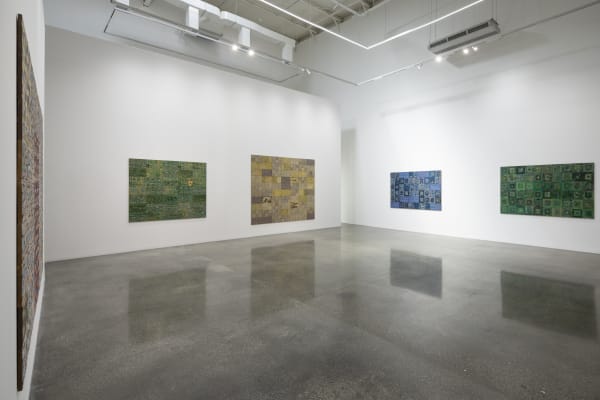
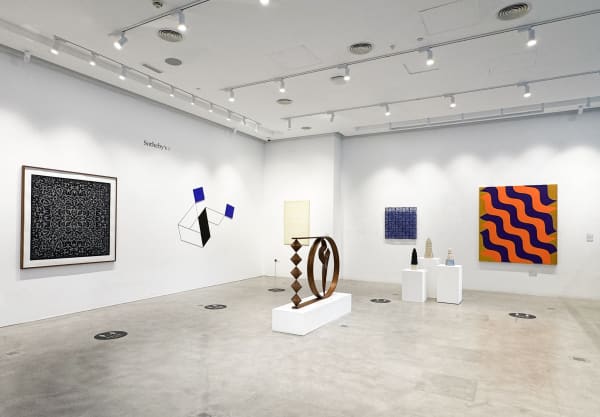







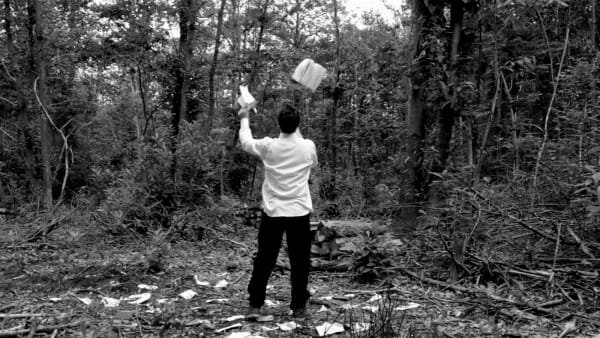




![Alia Ahmad: 'Aspects [مظاهر]'](https://artlogic-res.cloudinary.com/w_600,c_limit,f_auto,fl_lossy,q_auto/ws-lawrieshabibi2/usr/exhibitions/images/exhibitions/151/2024_sept_ls_installation-1.jpg)


